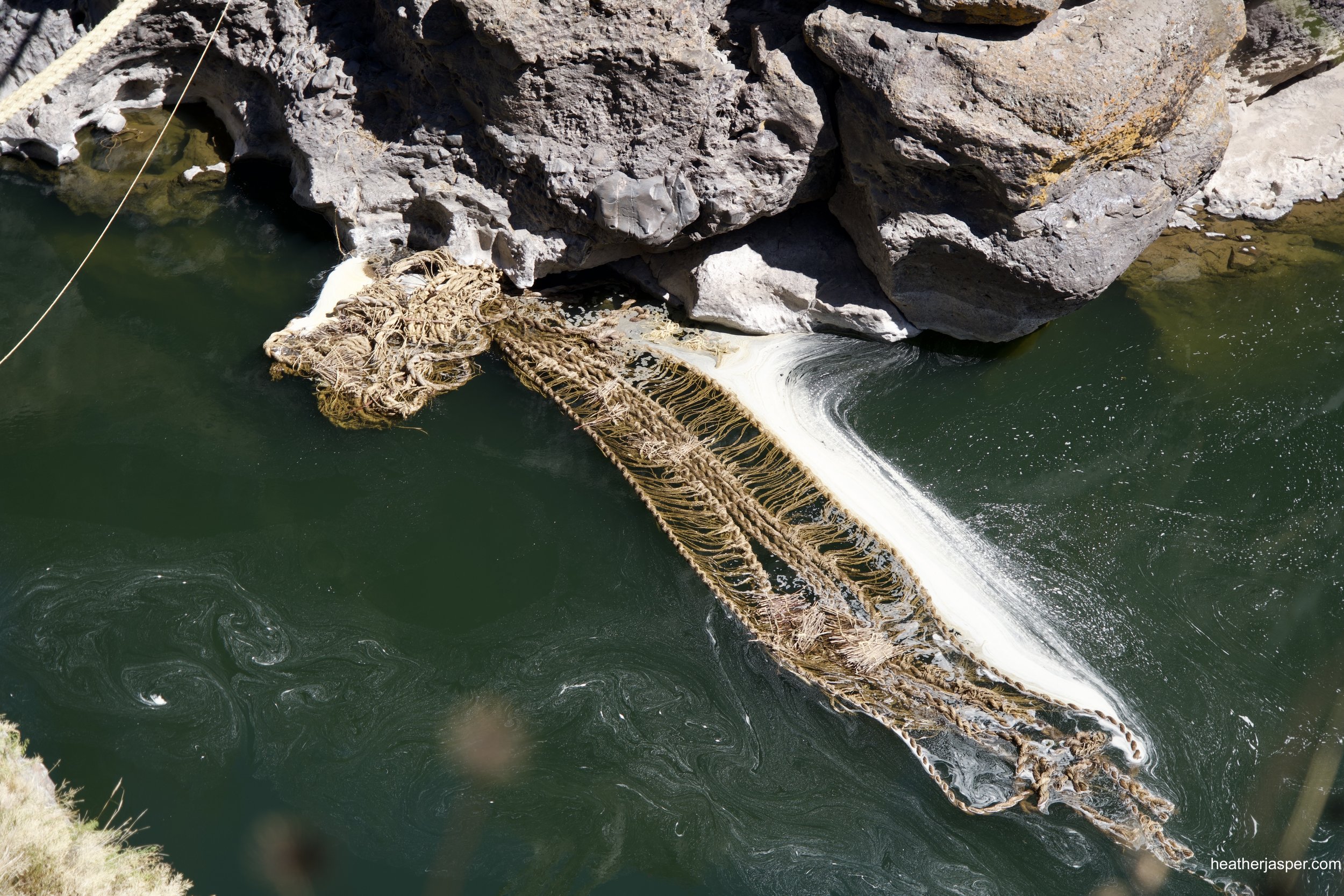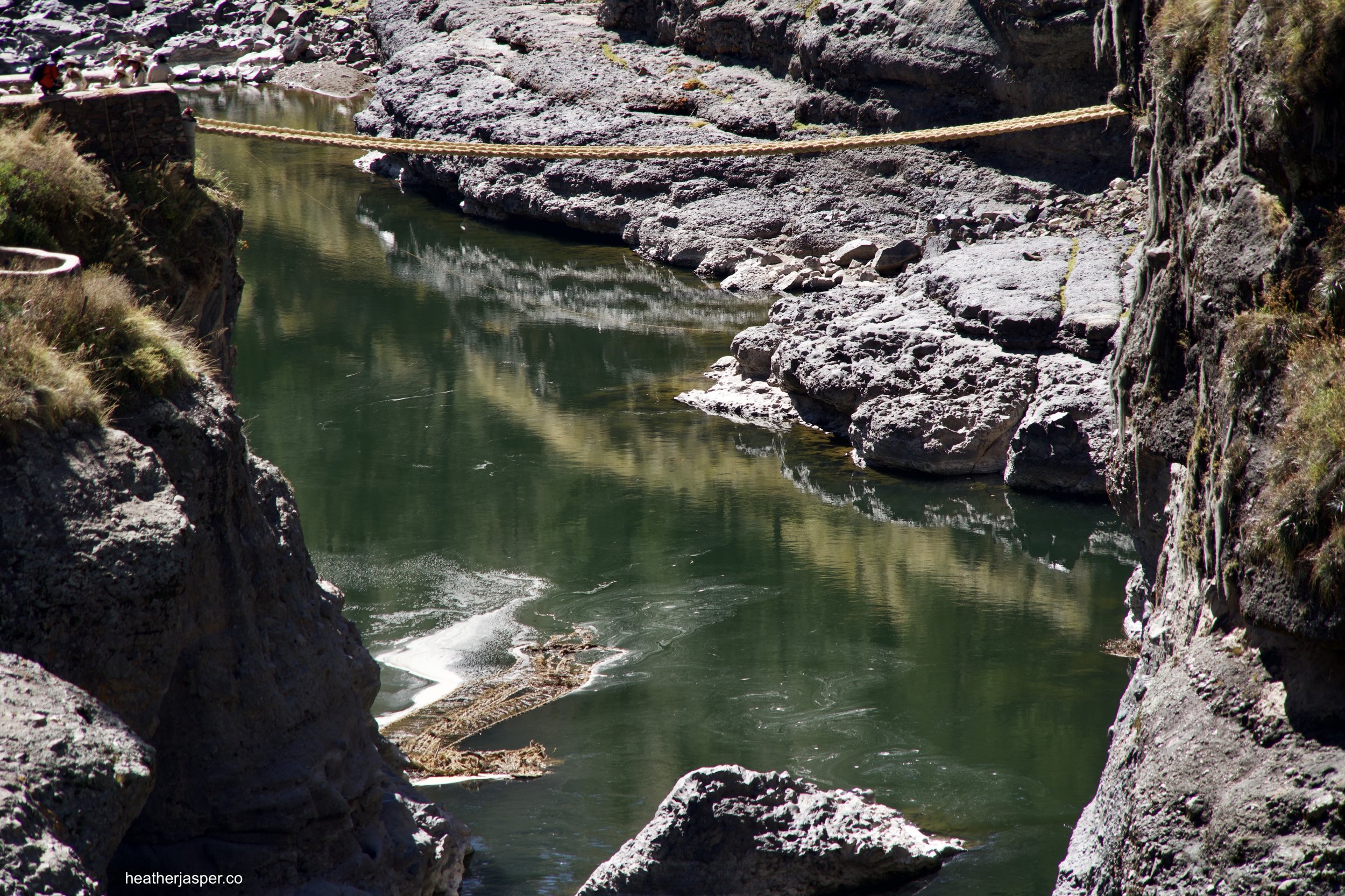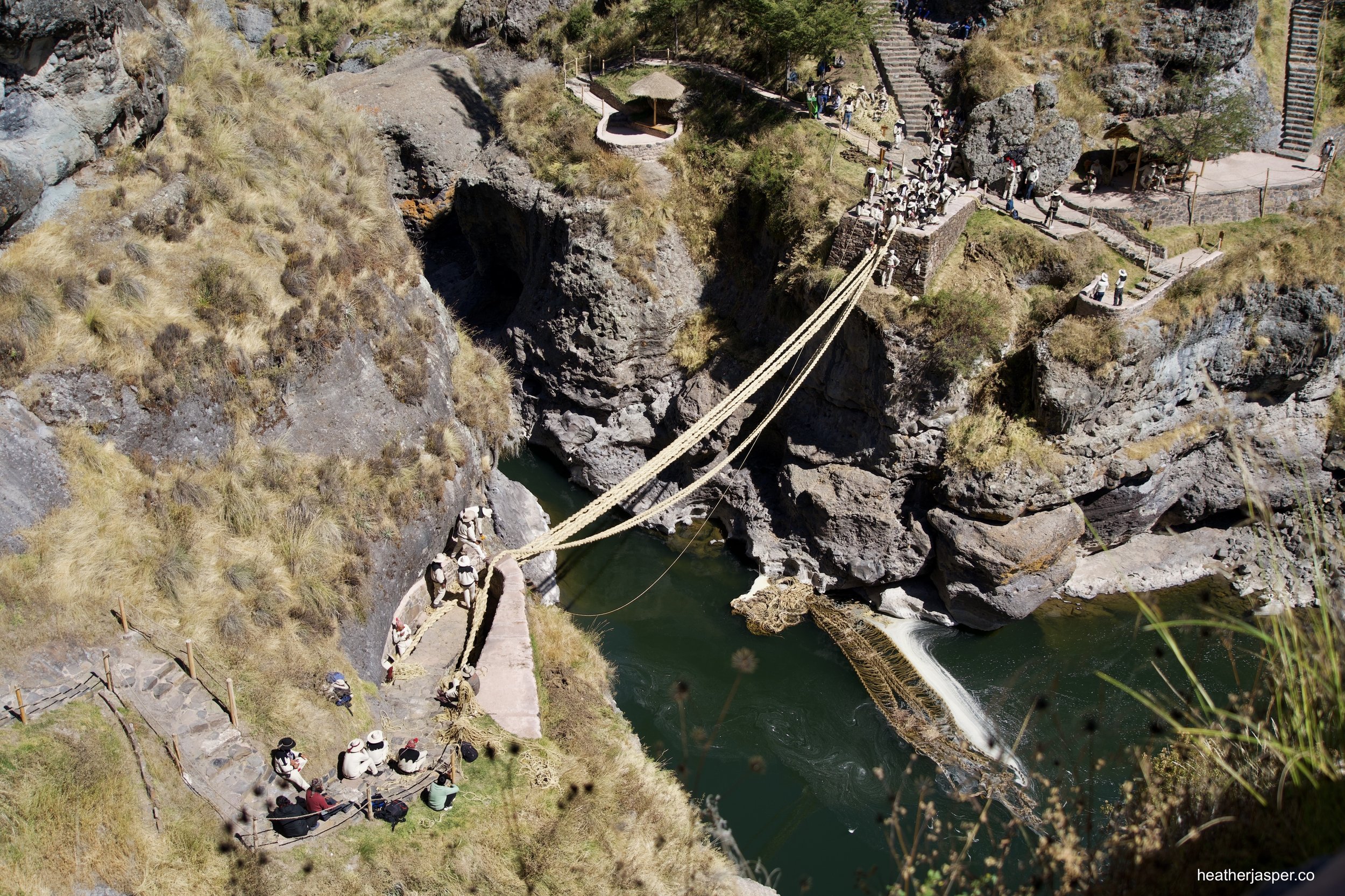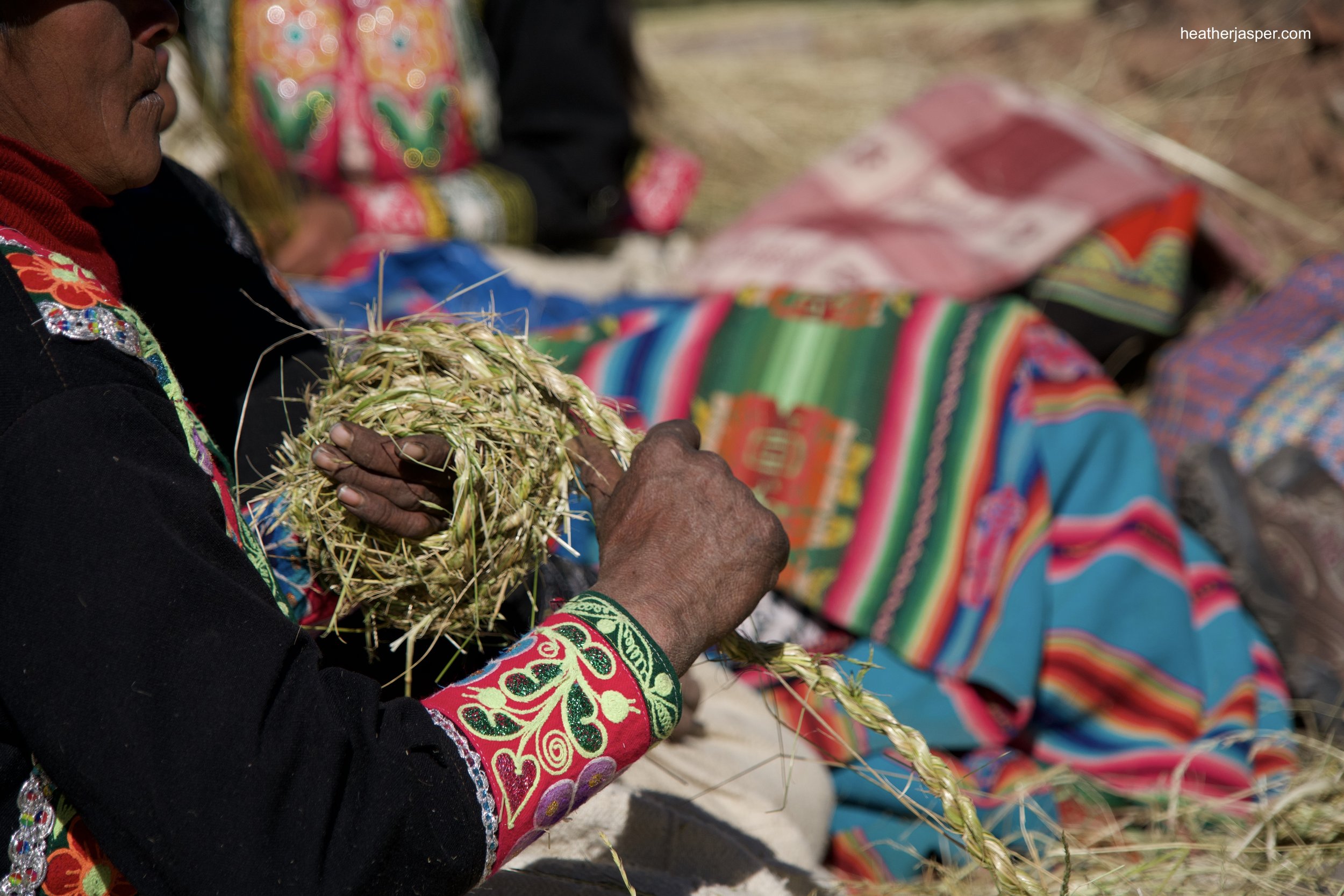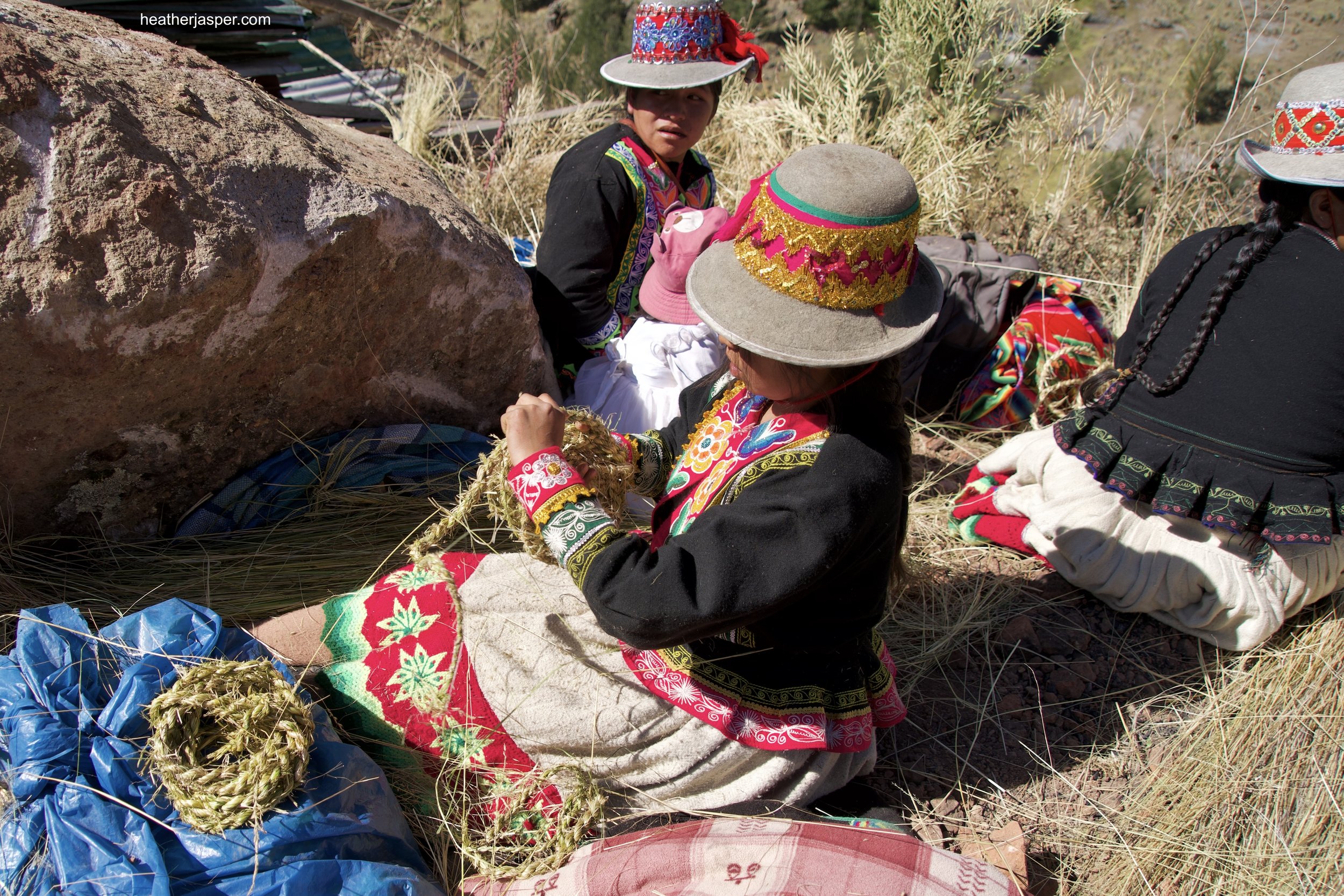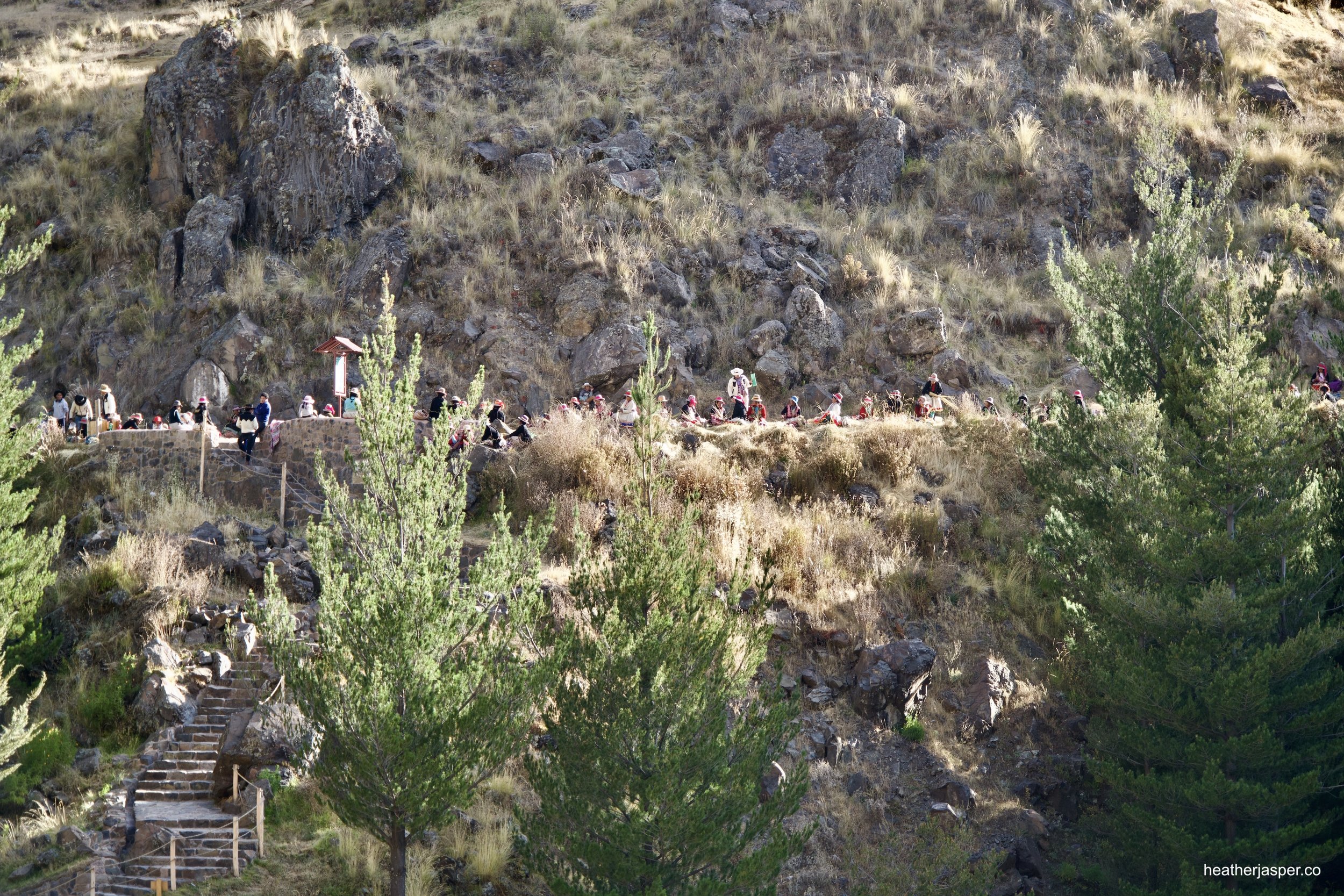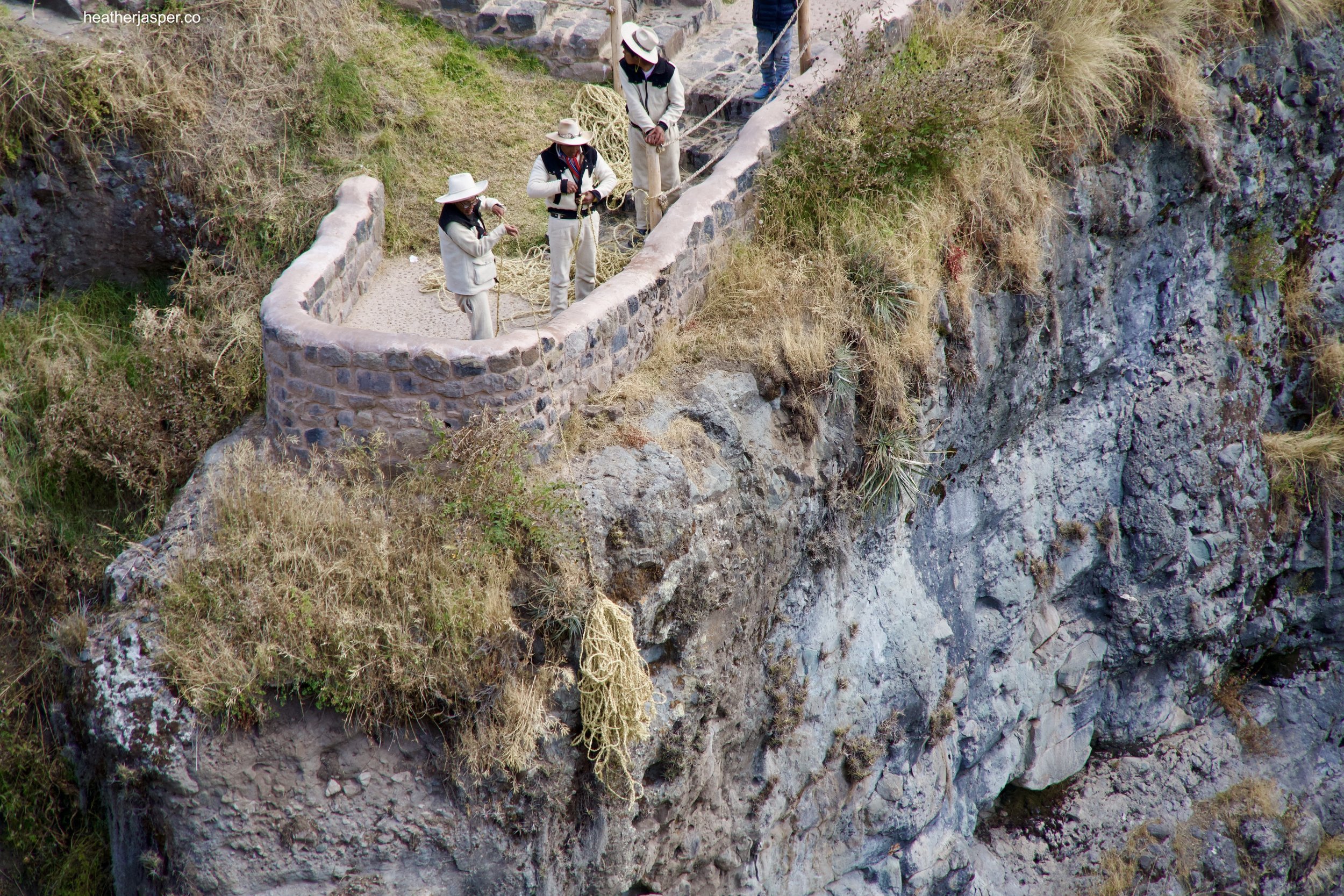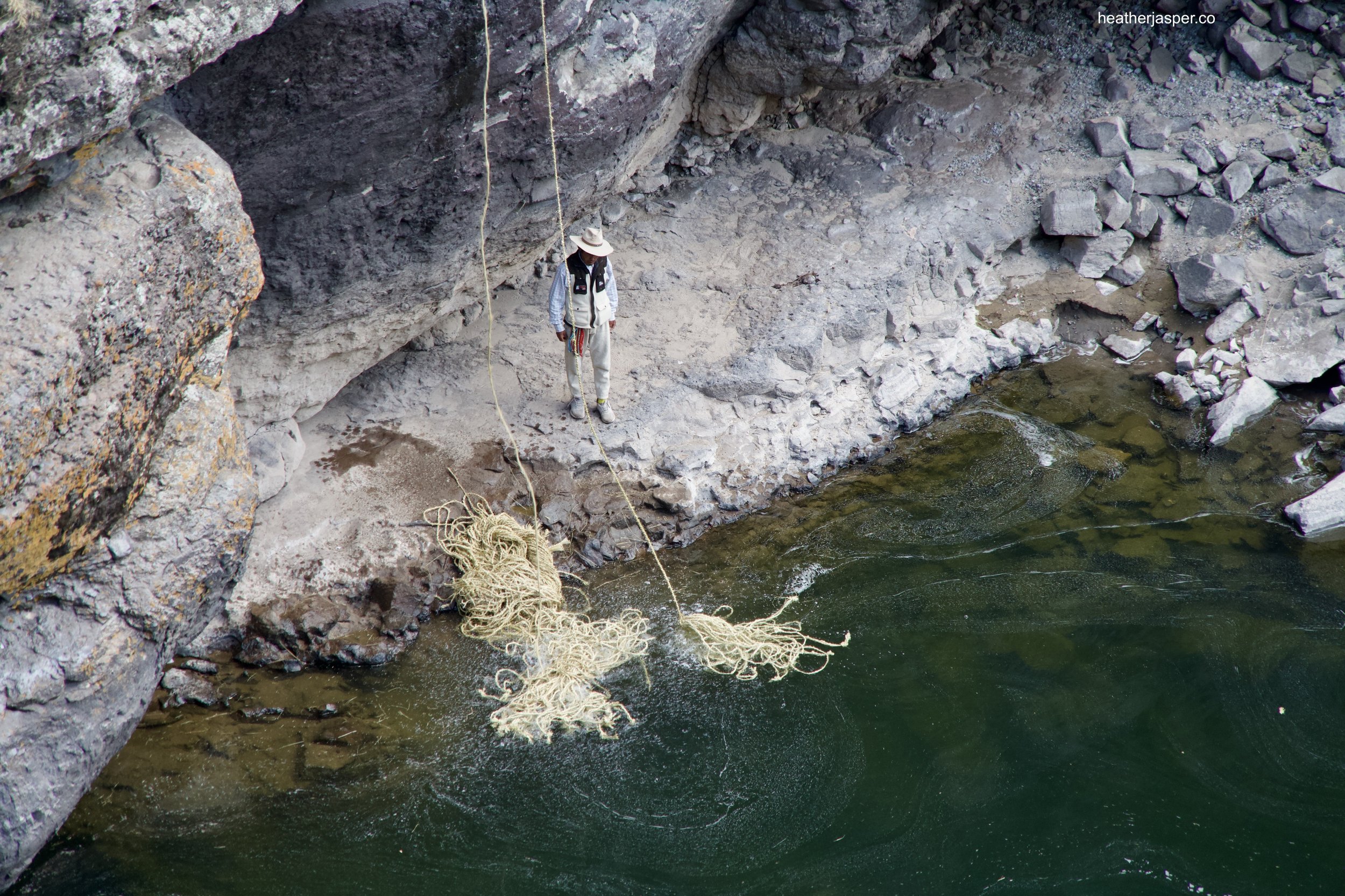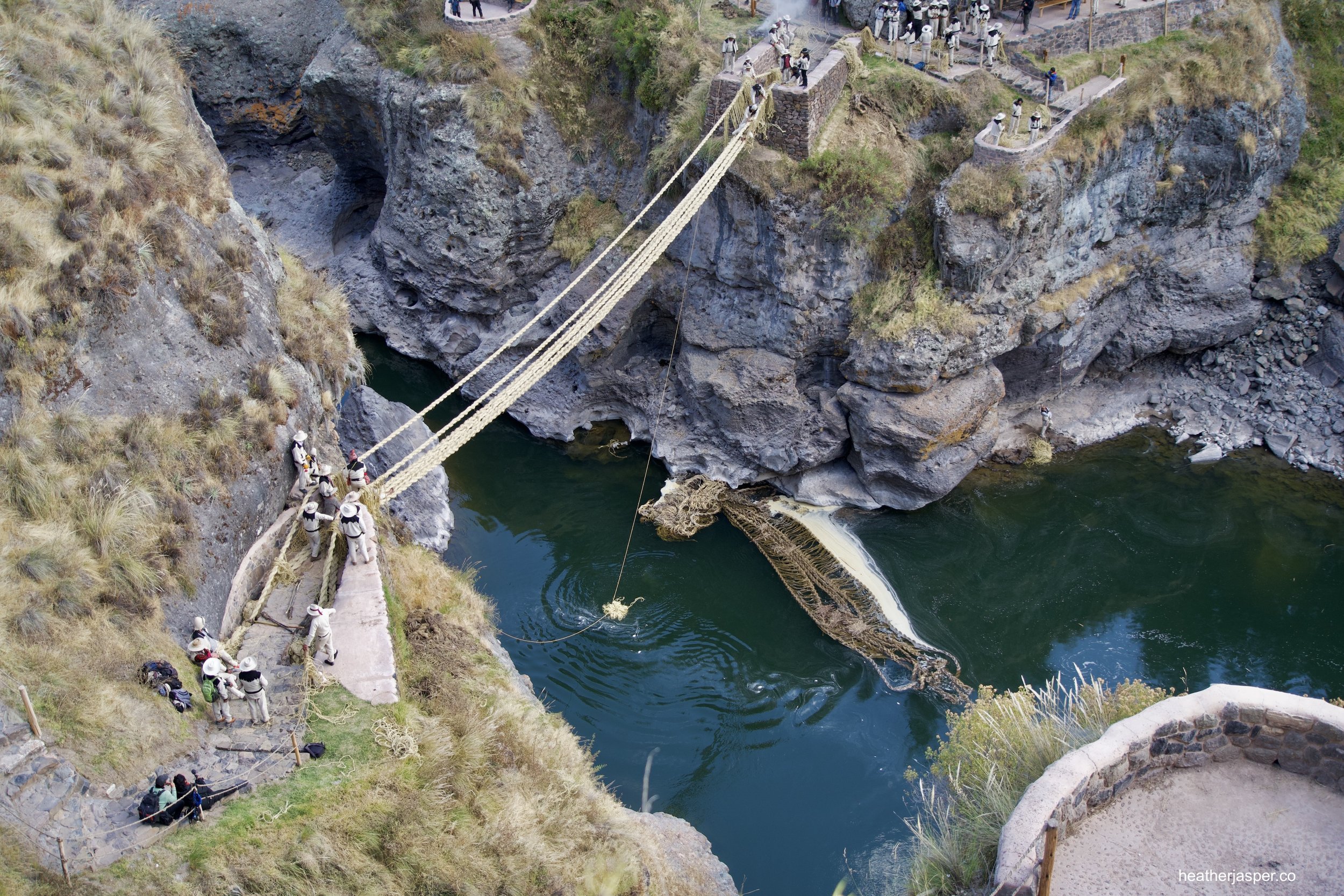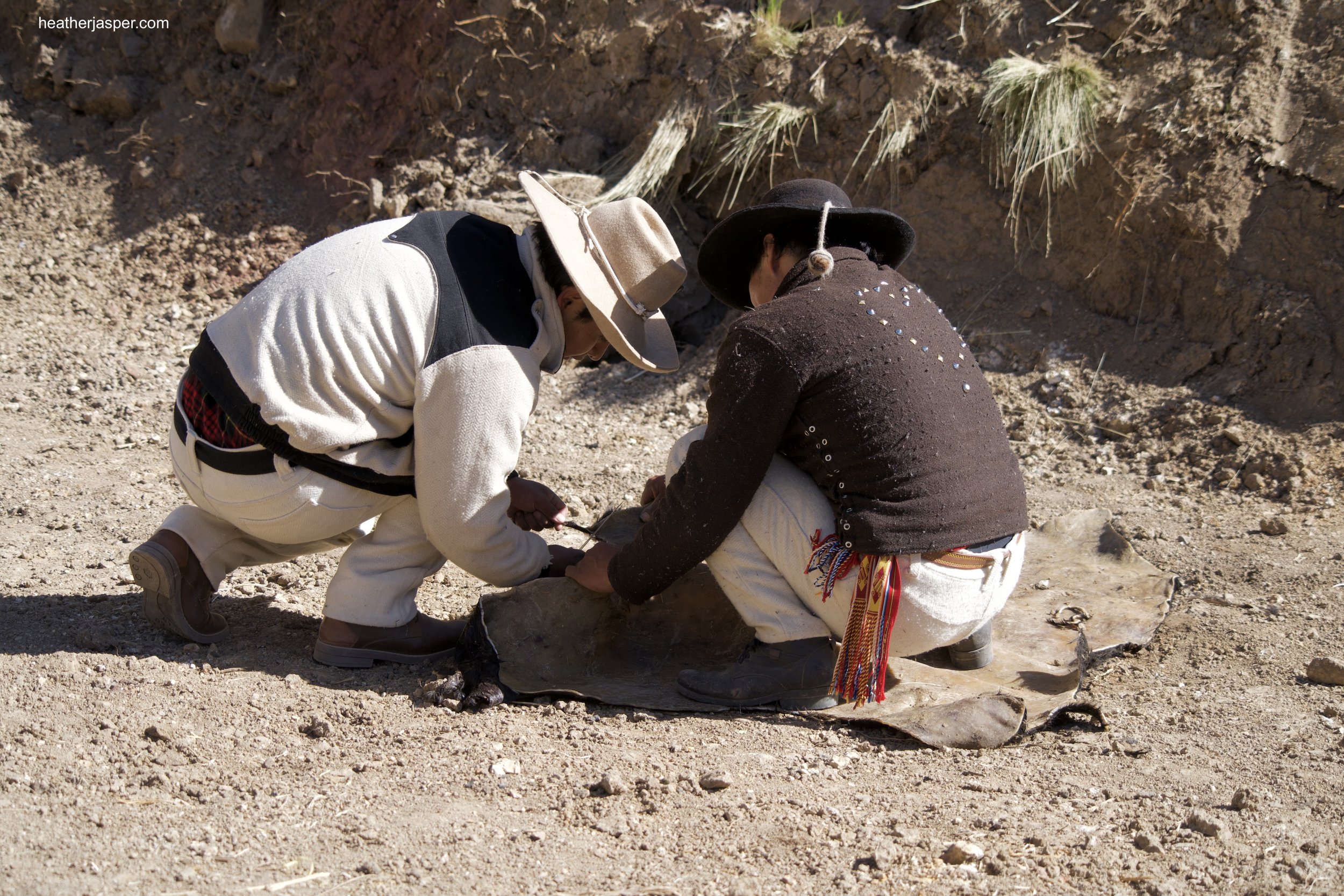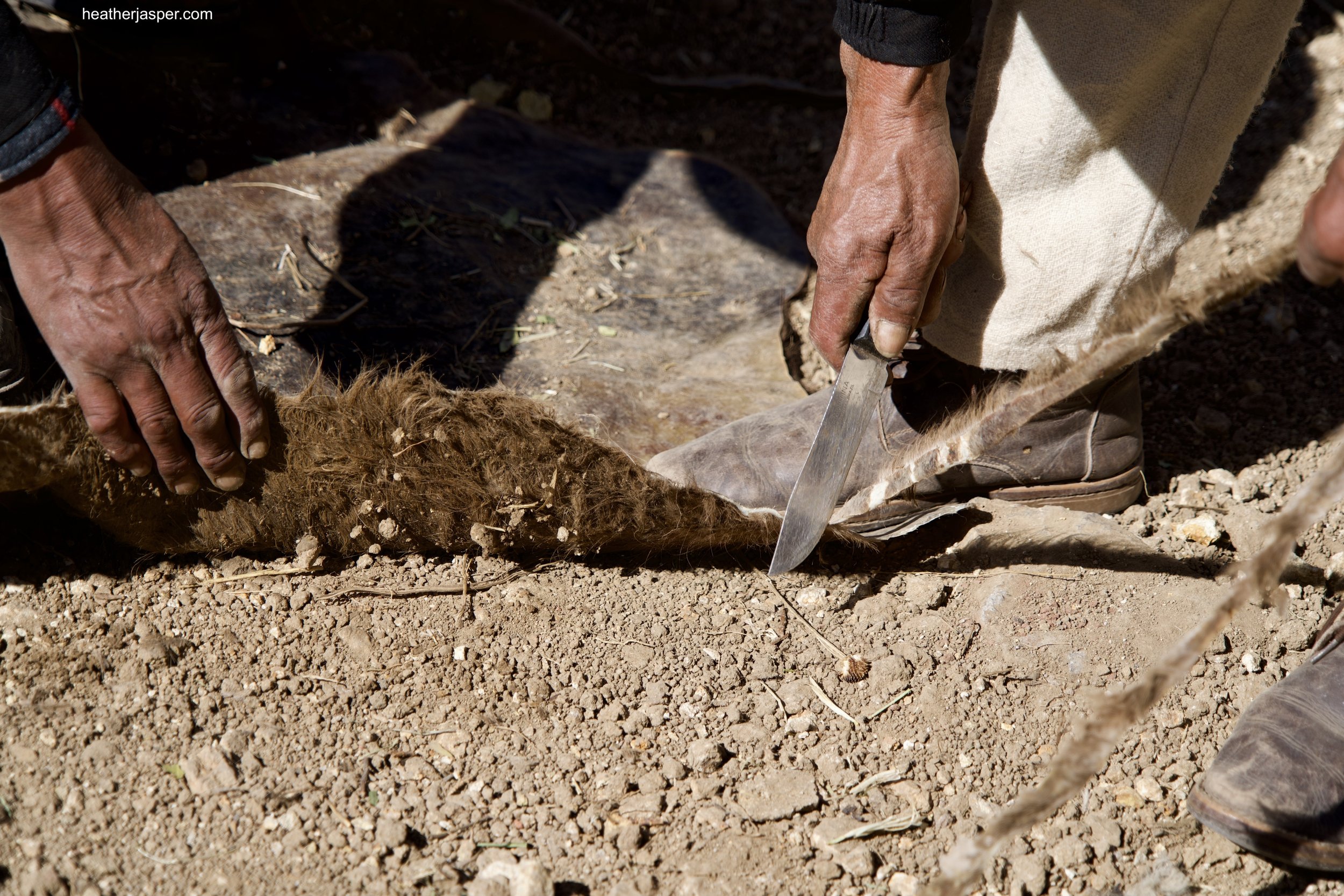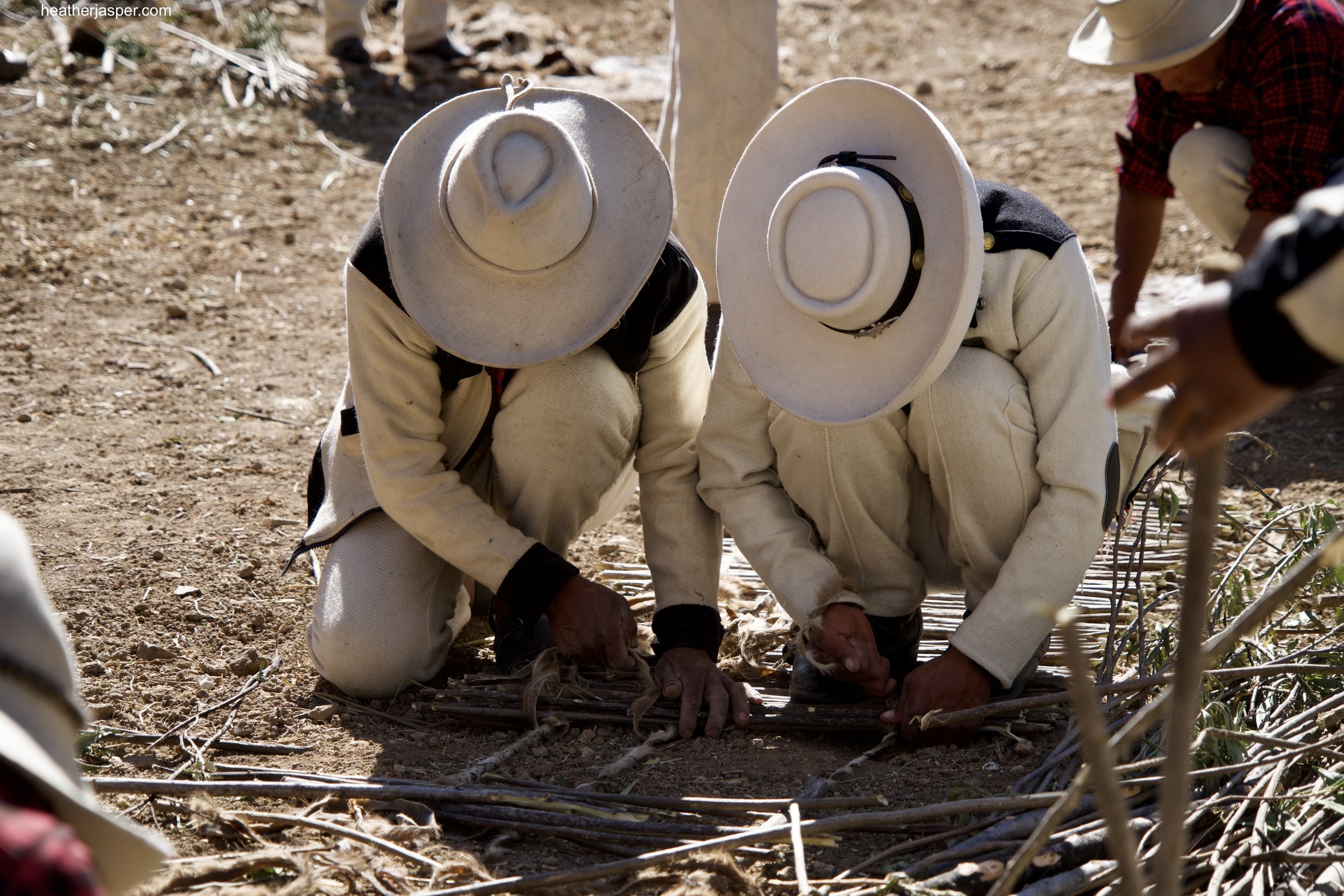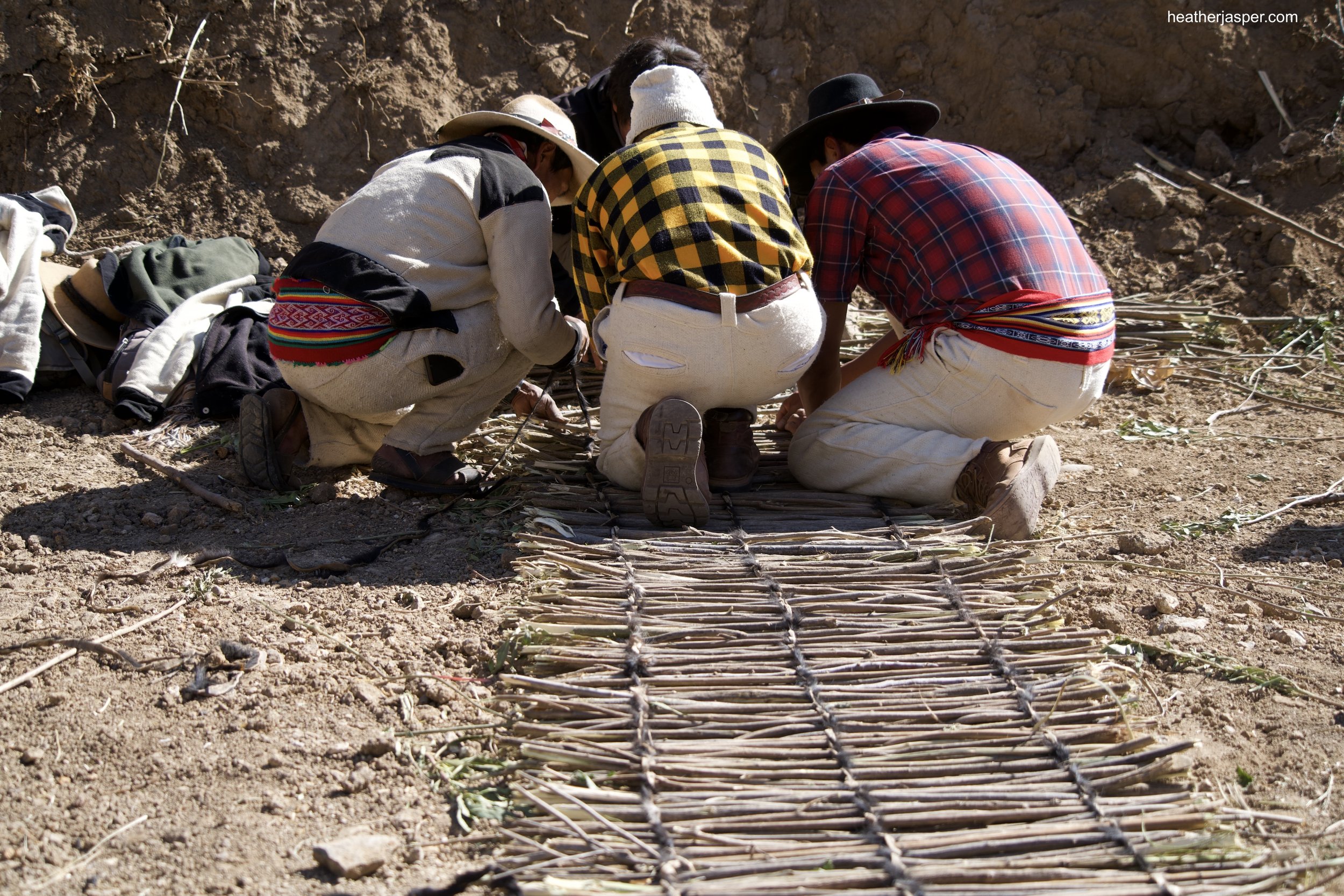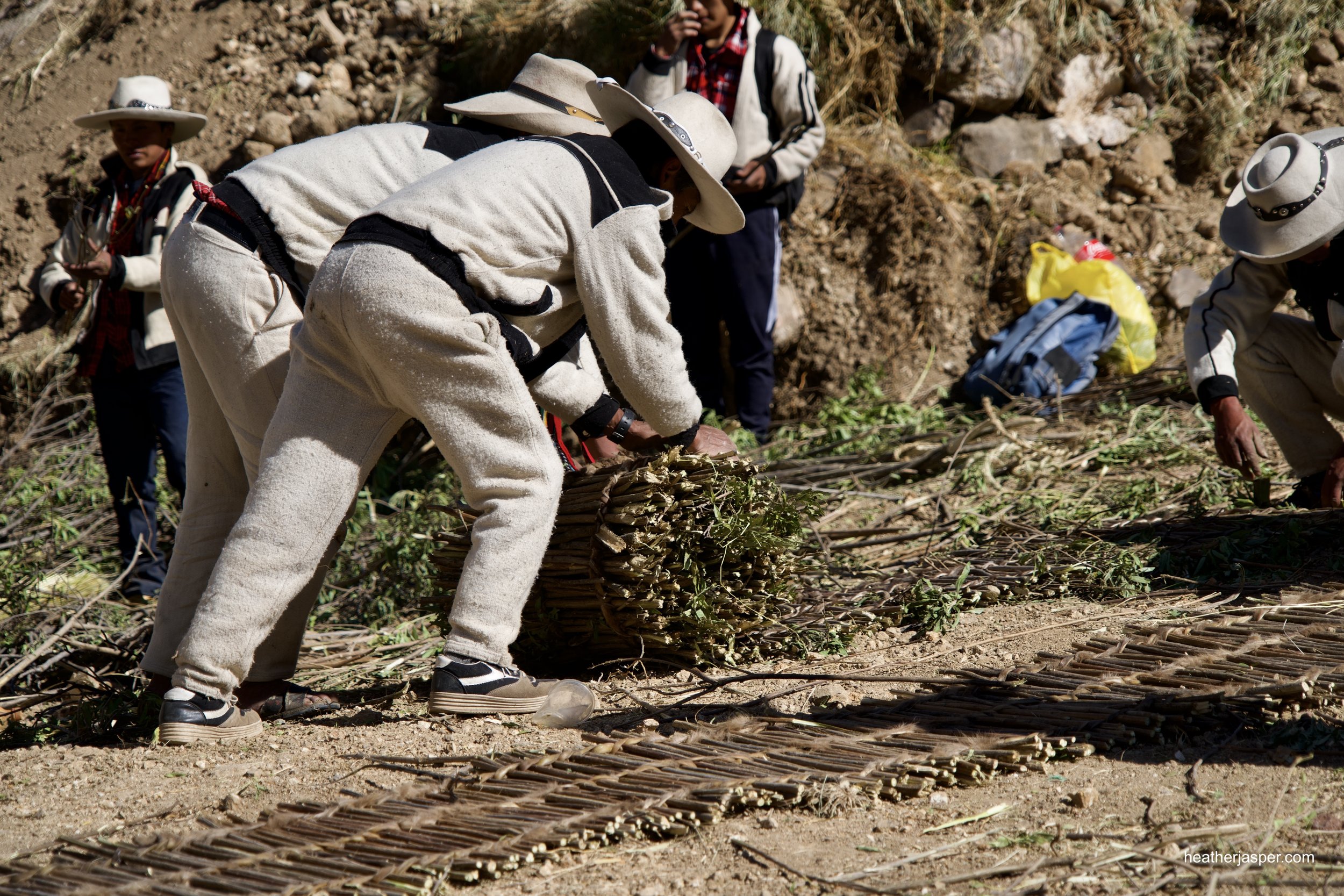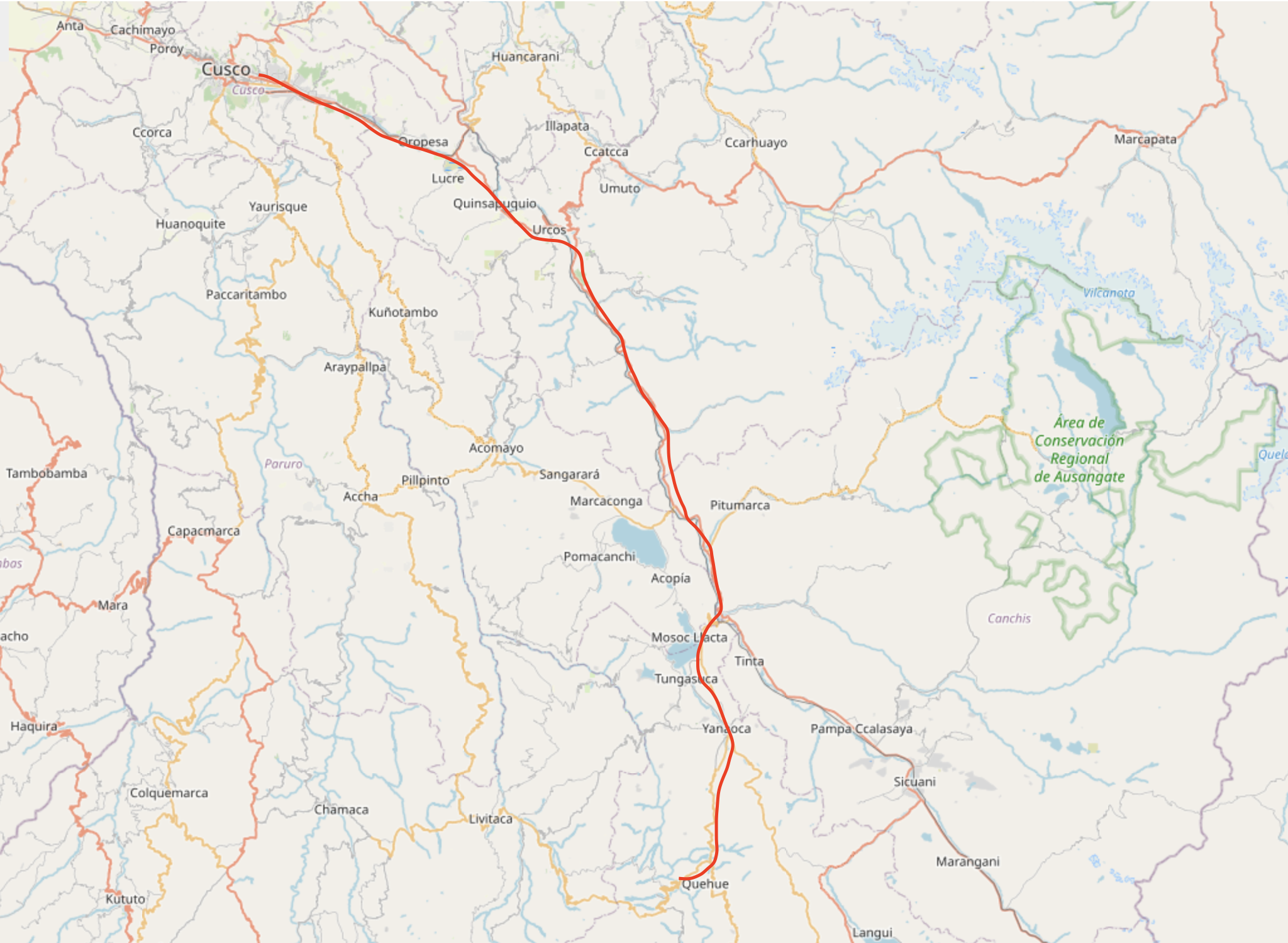Q’eswachaka Inca Bridge
Legend has it that the Apurímac River has a feminine energy and a jealous spirit.
Every year, while the Q’eswachaka Inca bridge is being rebuilt, only men go down into the canyon. They say that if a woman went into the canyon, the river might take one of the men.
The Apurímac River didn’t look very dangerous on the sunny June day that I watched the Q’eswachaka bridge being rebuilt. It hadn’t rained in weeks and the water level was low, the current slow through the canyon.
The old Q’eswachaka bridge
Before a new bridge can be built, a new rope is strung across to facilitate getting materials across the canyon and the old bridge is cut down. It’s made entirely of grass, sticks and strips of raw leather and eventually sinks and biodegrades at the bottom of the river.
Until about twenty years ago, the Q’eswachaka bridge was rebuilt every year in January. That’s one of the rainiest and stormiest months of the year, second only to the torrential rains of February. (The Inca Trail is closed every year in February because mudslides across the trail are too common). Rebuilding in January was infinitely more dangerous and not only for the fury of the Apurímac River. The tradition was moved to June when a young man was struck by lightning and killed during a particularly fierce January storm.
The first ropes
Four giant braids are pulled across the canyon and fastened to the east (right) side. There used to be dozens of grass bridges throughout the Andes, but modernity has done away with all but this last one. I took this photo standing on a steel and cement bridge, which is obviously what cars use.
The Q’eswachaka bridge is built with qoya ichu grass, a strong fiber that only grows high in the Andes. Gathering the grass is the first step in rebuilding. For several days, people go out into the mountains near their villages to cut the grass close to the ground with old-fashioned scythes.
Four communities work together to build the bridge: Huinchiri, Chaupibanda, Choccayhua, and Ccollana Quehue. They are all small villages who live near the canyon, and who would have used the Q’eswachaka bridge, until the modern bridge was built a few years ago. Still, they come together every year to continue this tradition, as much for the annual social event as for the historic continuation of their ancestors’ ingenuity.
Tensing the bridge
After the four braids that make the floor have been brought across, dozens of men pull in unison to tighten them. They’re tied on the east (left in this photo) side and pulled taut by crews on the west side of the canyon.
Rope made from grass
Qoya ichu grass may be strong enough to build a bridge, but it’s not particularly easy to work with. Grass is soaked with water and pounded with rocks to make it easier to twist into ropes.
While the men work down in the canyon, women stay along the canyon rim, twisting the ropes that will make the sides of the bridge. They have already spent the previous day twisting the giant ropes that make the floor and handrails of the bridge. These side ropes are the easy part, comparatively.
Only the ropes that make the floor of the bridge are braided. The handrail ropes and the smaller side ropes are twisted. Each side rope has to be roughly the same length, to stretch from the floor of the bridge, up over the handrail and back down. Women twist two strands of grass by rolling them between their palms. Each strand has to twist the same amount, at the same time. They constantly have to add more strands of grass as they twist the ropes, because the grass strands are only about the length of an arm and the ropes must be at least three meters (10 feet).

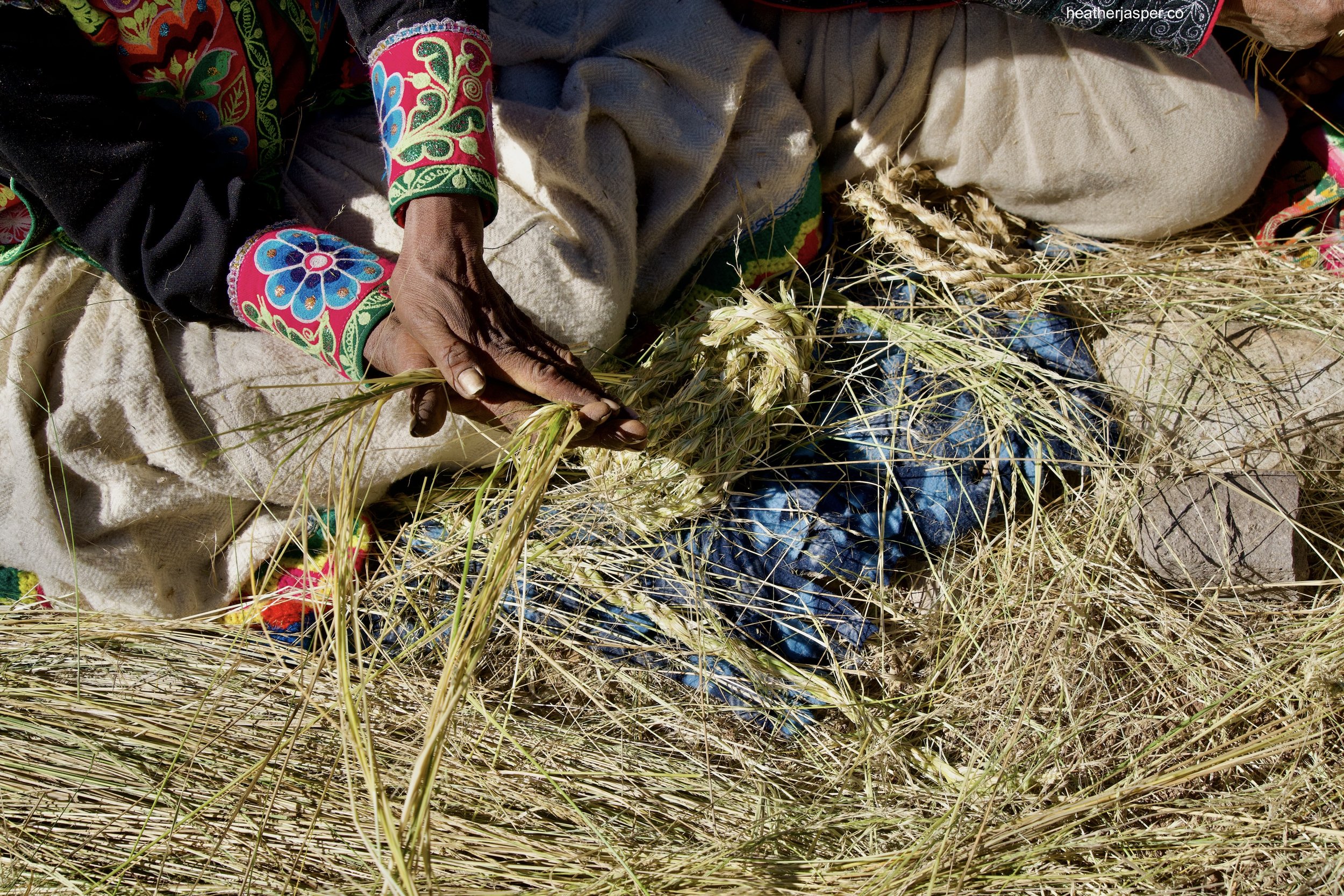


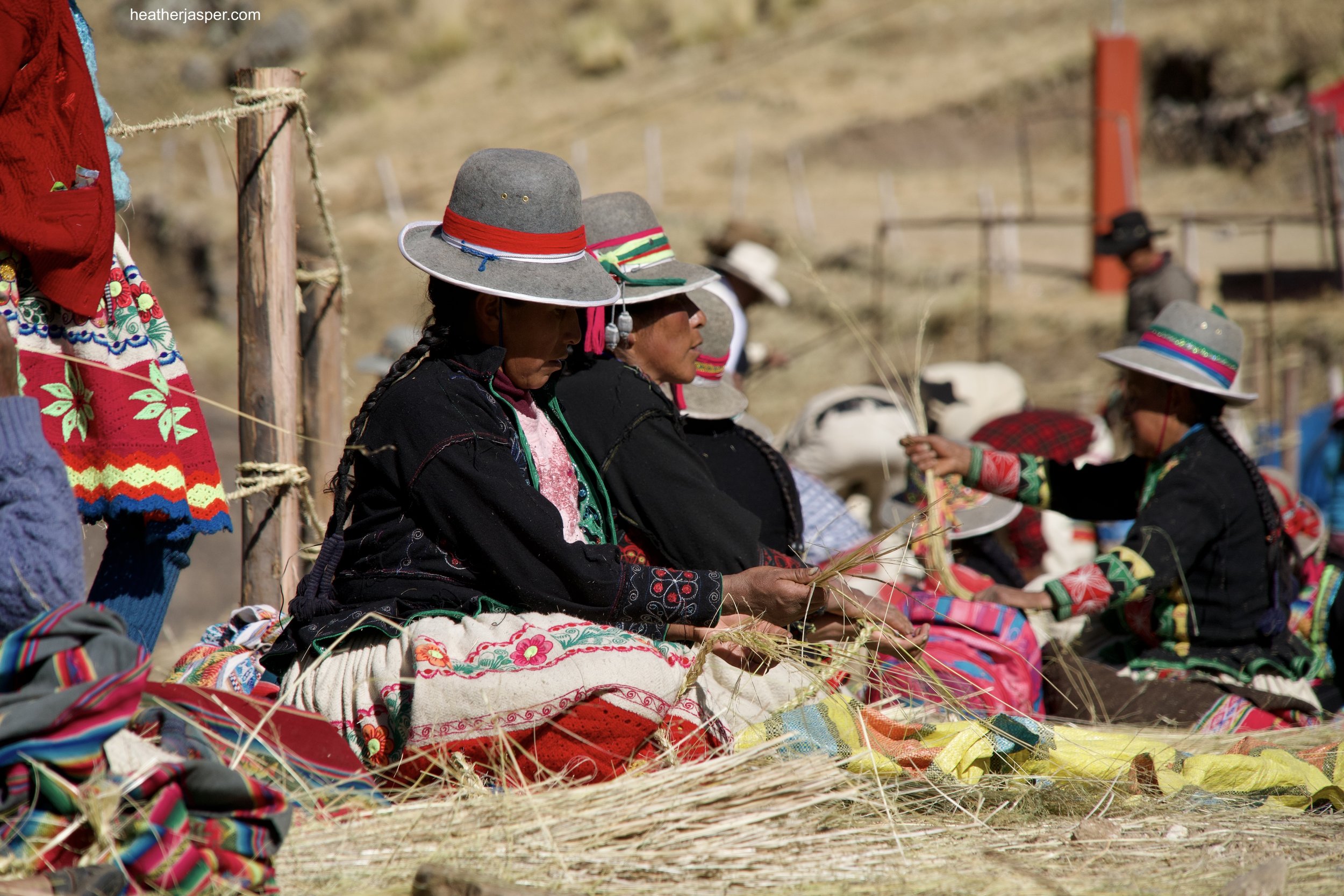
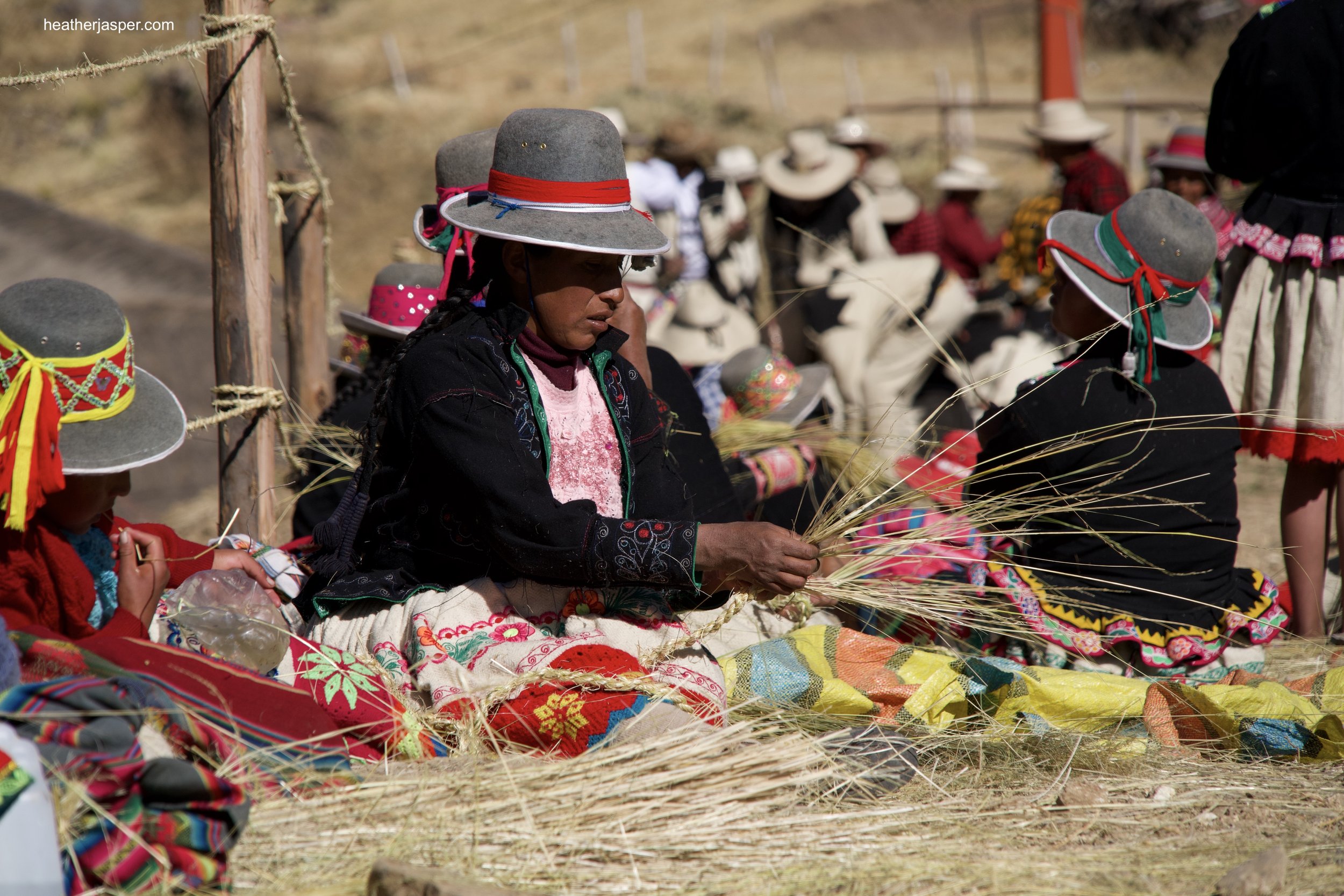
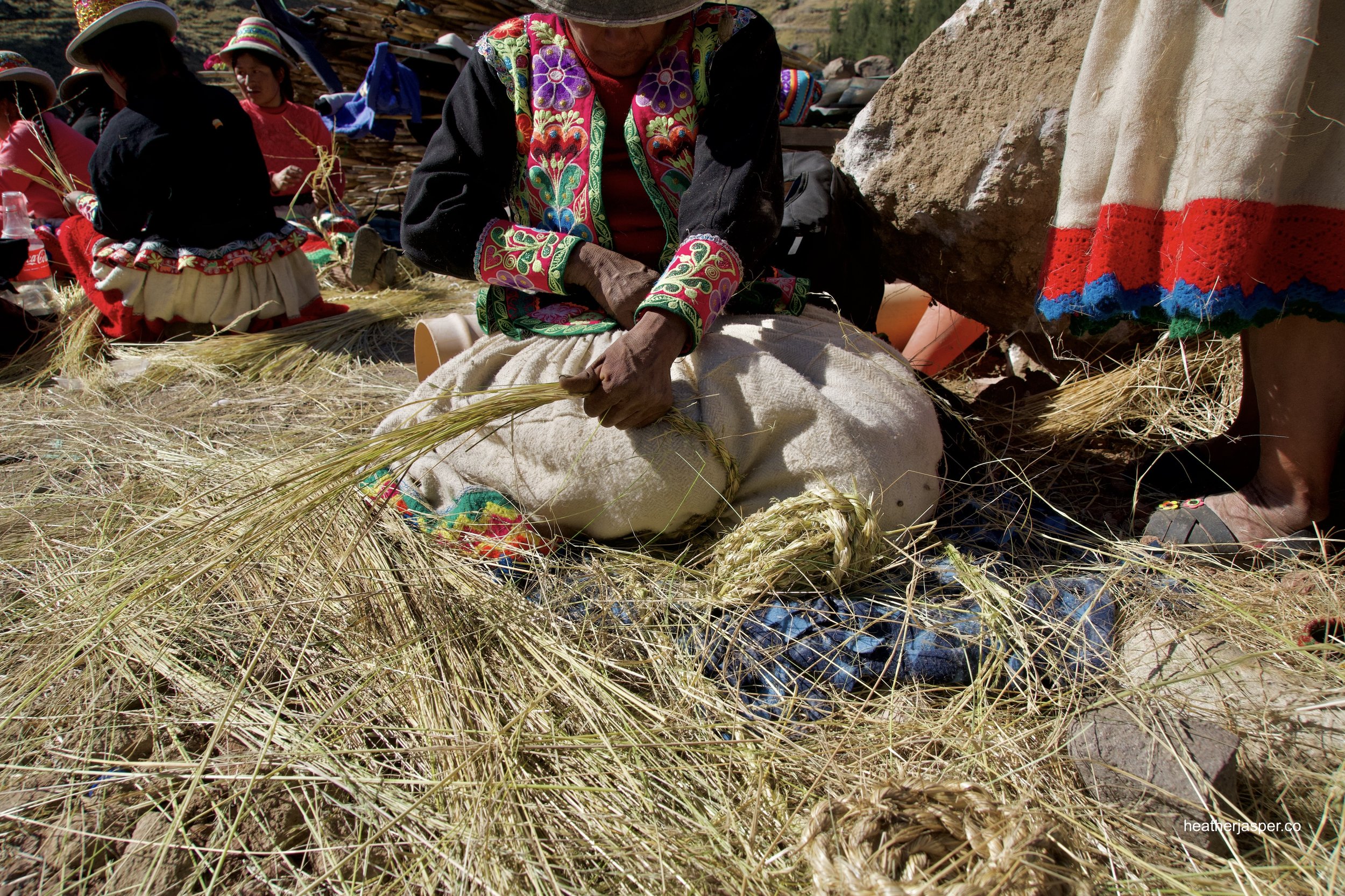
I tried this and it’s not hard to do, but it is hard to do well. I got my two strands to twist correctly, rolling them through my palms. I didn’t pull them apart often enough to make the twists tight enough to be very strong. I also didn’t have the knack of knowing how often and how much more grass to add while I was twisting so the rope was the same width the whole way. I am positive that my contribution wasn’t used in the final bridge, so you shouldn’t worry about walking across it this year!
I loved the women’s hats and was impressed with their skirts. I’ve traveled a lot around the Cusco region but I’ve never seen skirts made of homespun alpaca wool like these. I’ve also never seen skirts with trim that’s crocheted. The men’s pants and jackets are made with the same rough, homespun alpaca wool fabric.
The canyon rim
From the east side, I looked across to the west canyon rim, where women sit all day, twisting ropes for the sides of the bridge.
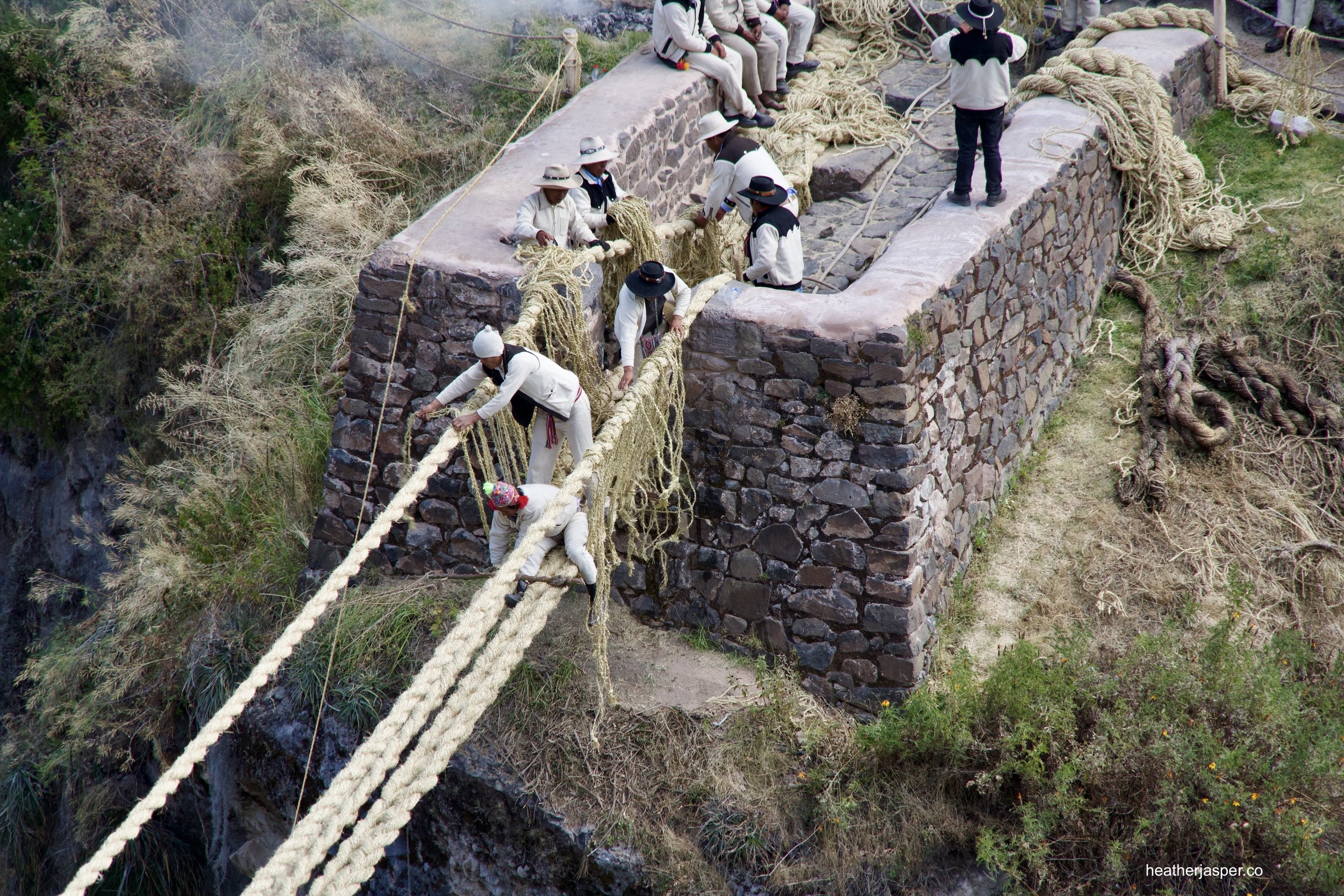
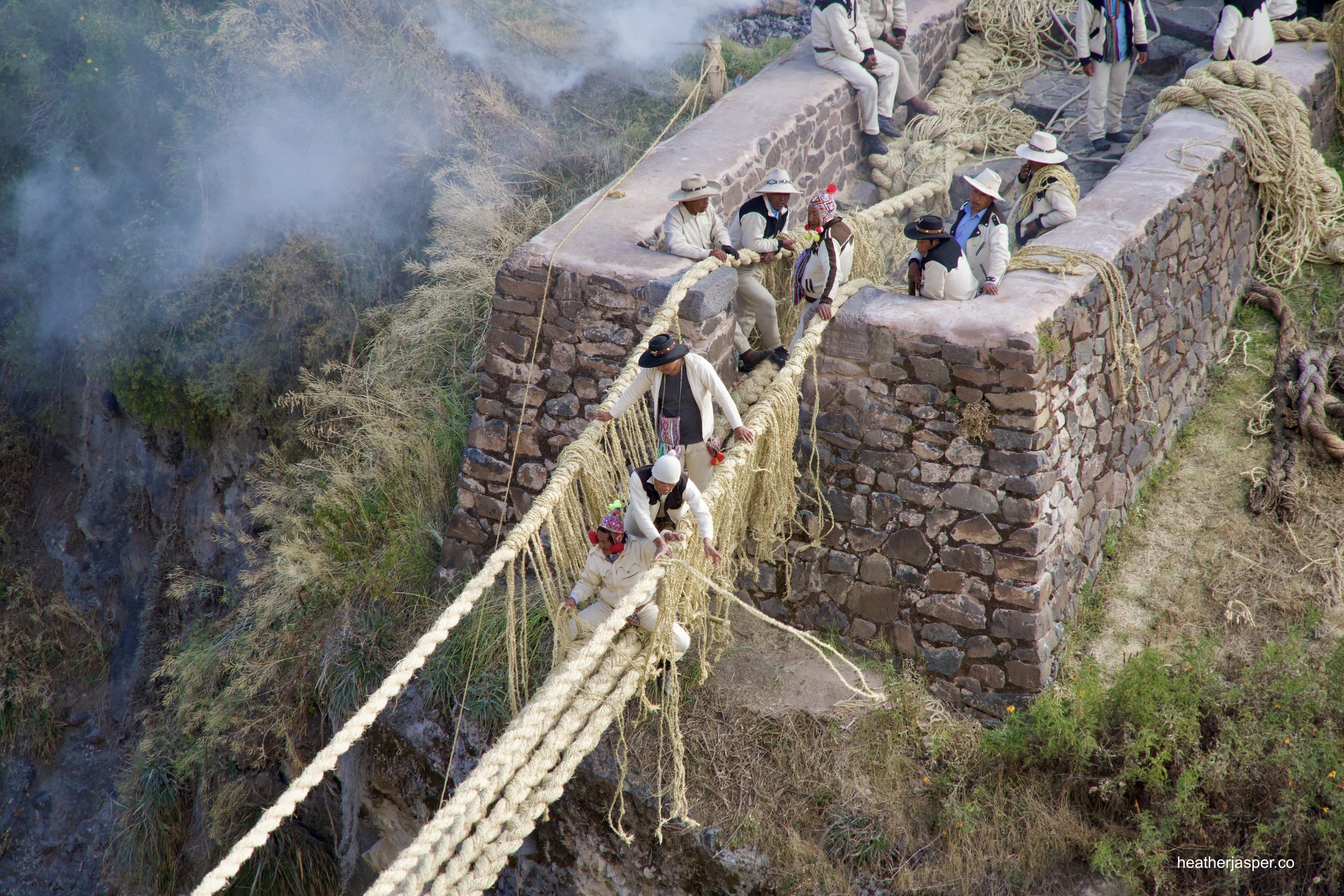

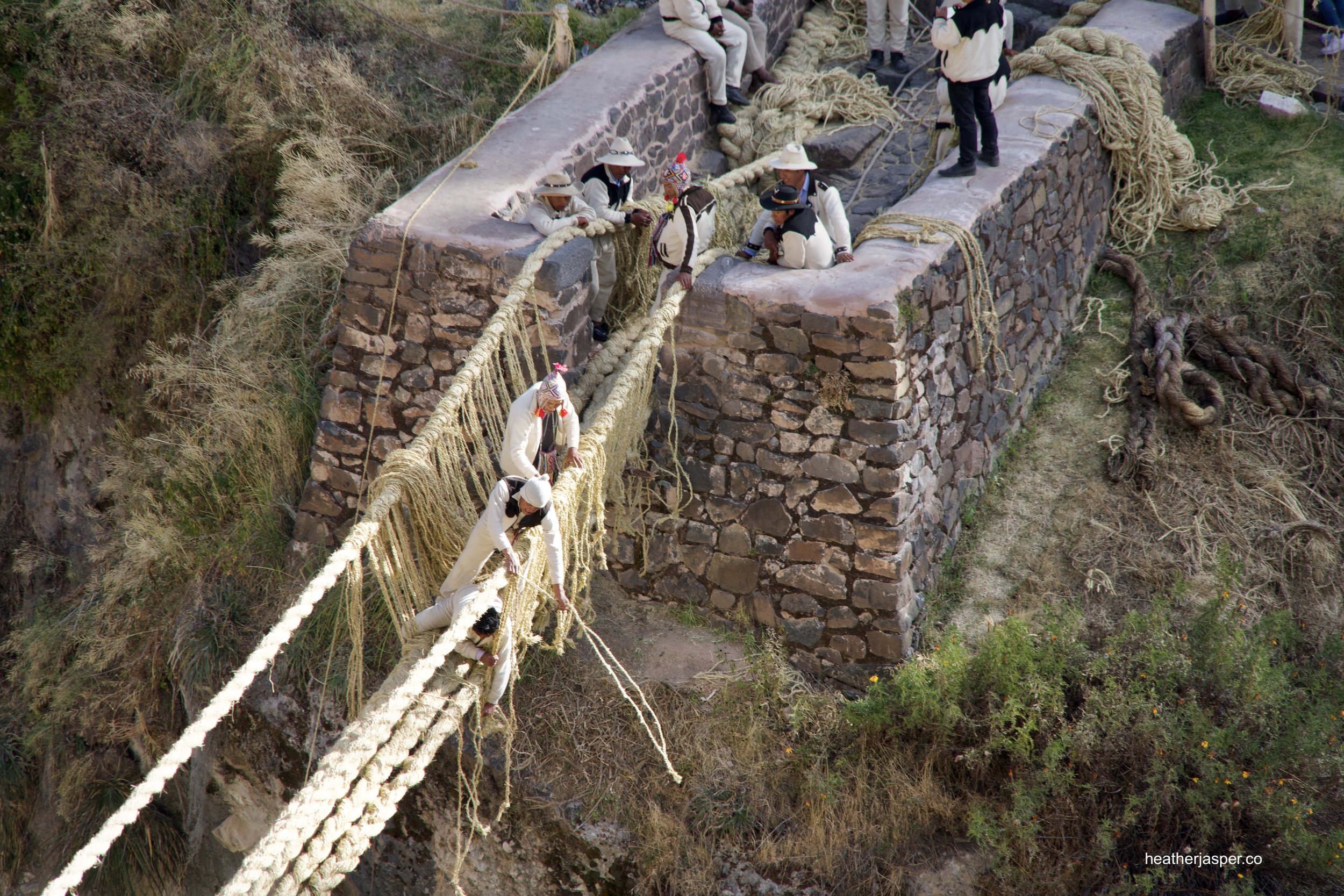
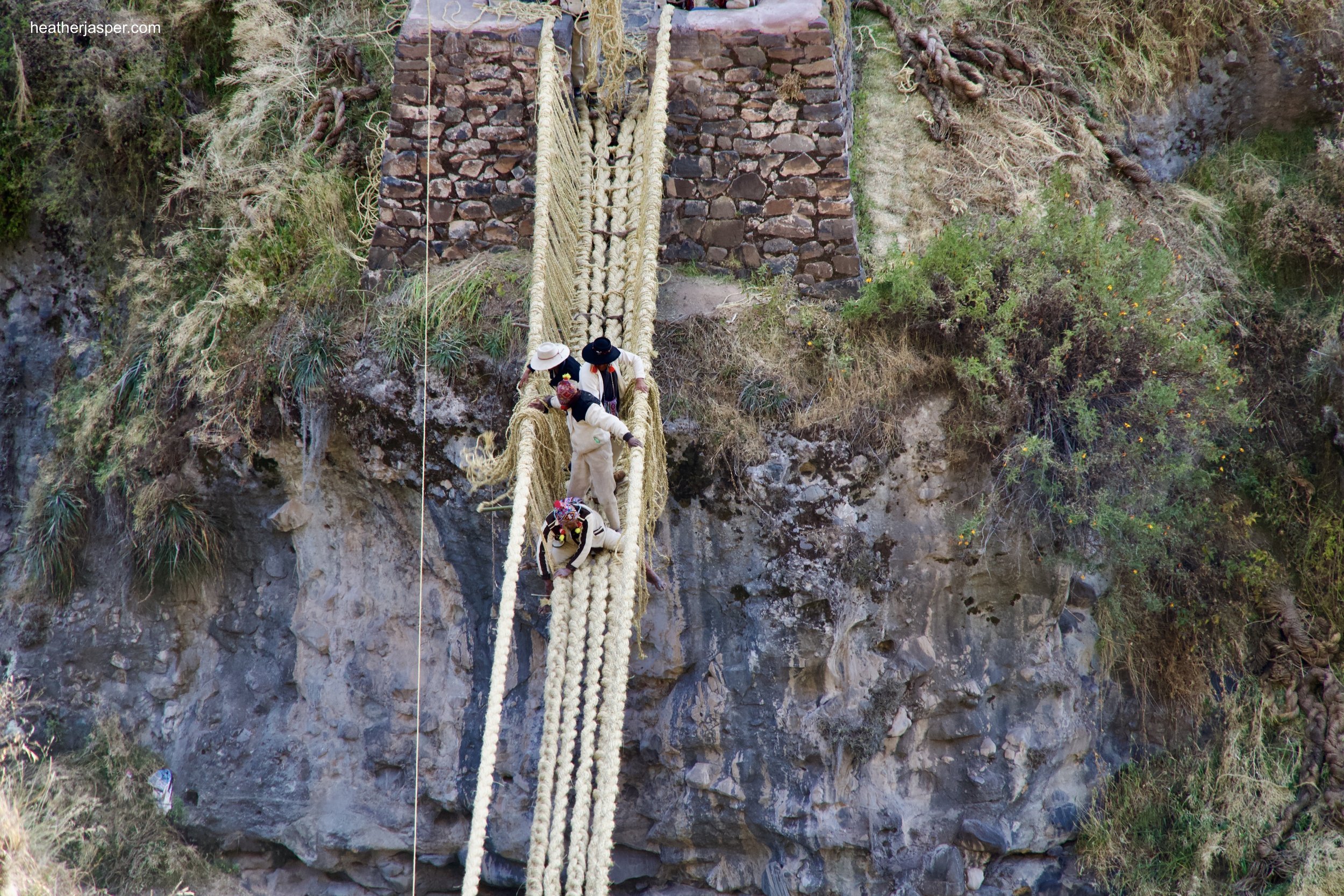

After the four braided ropes and two twisted handrail ropes are pulled across and tightened, it’s time for the sides. From both sides of the canyon, men inch out along the bridge, tying the floor ropes together and tying on the sides. Every meter or so they tie a stick across, to make the four braided ropes into a functional floor. The photos above are the progress from the west side of the canyon and below is the group working from the east side.
The smoke on the west side is from a sacrifice made by a pacco, a kind of Andean shaman. Sacrifices are called “pago a la tierra” in the Cusco region, a payment made to the earth. They include coca leaves, fruit, sweets and today have a chunk of llama fat and some animal crackers to represent a real llama. I couldn’t see what when into this pago, but it was far too small to have a llama in it.
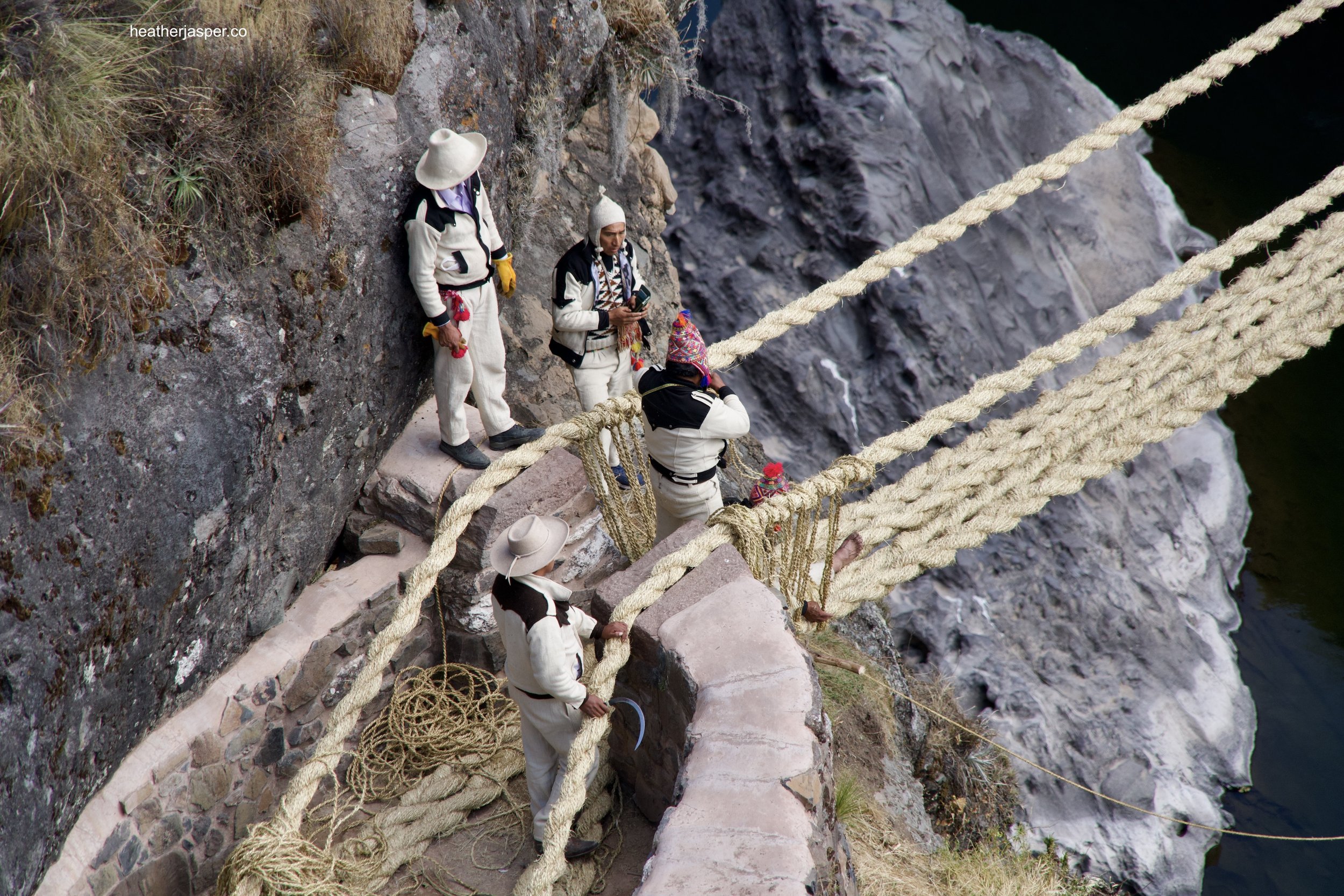
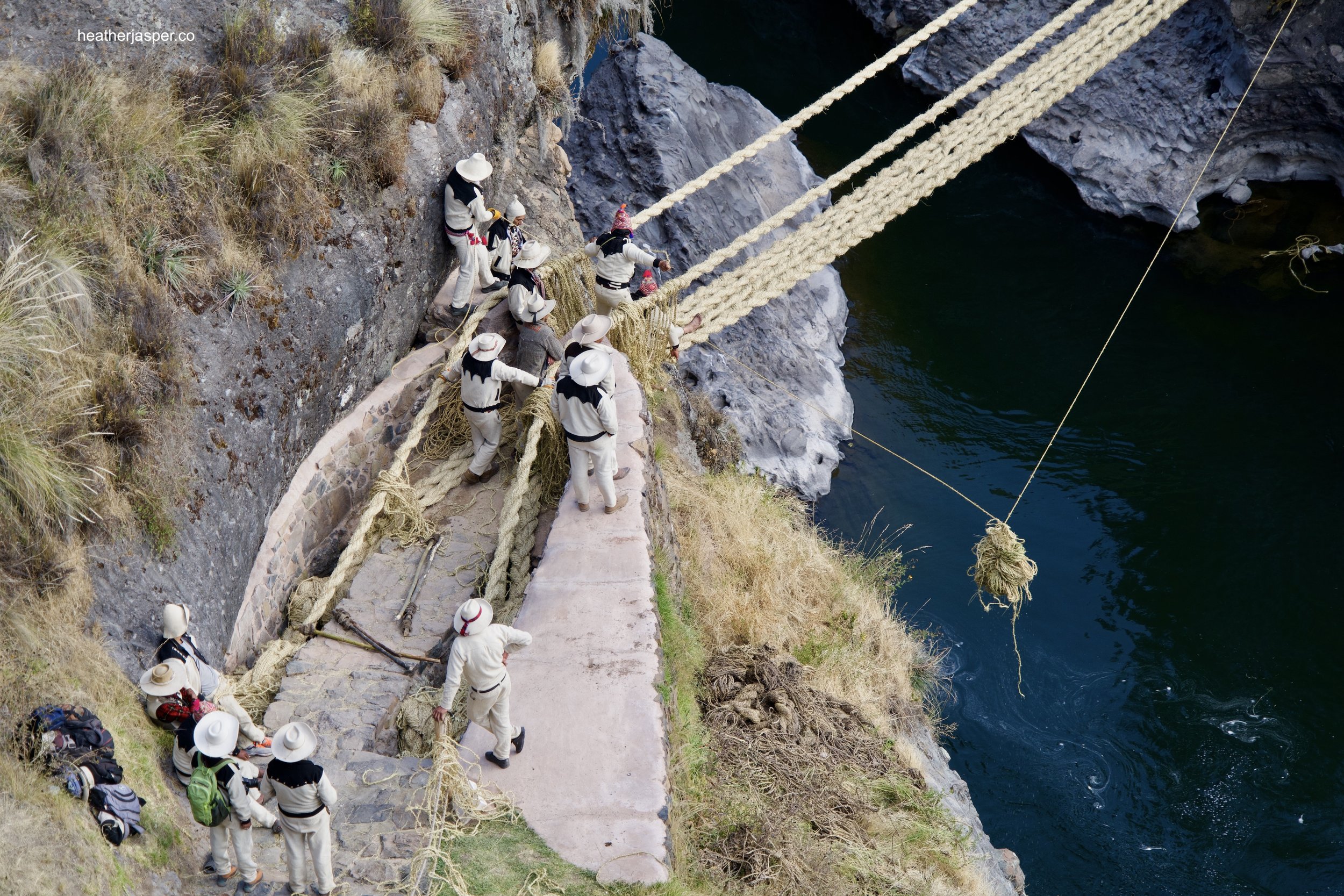

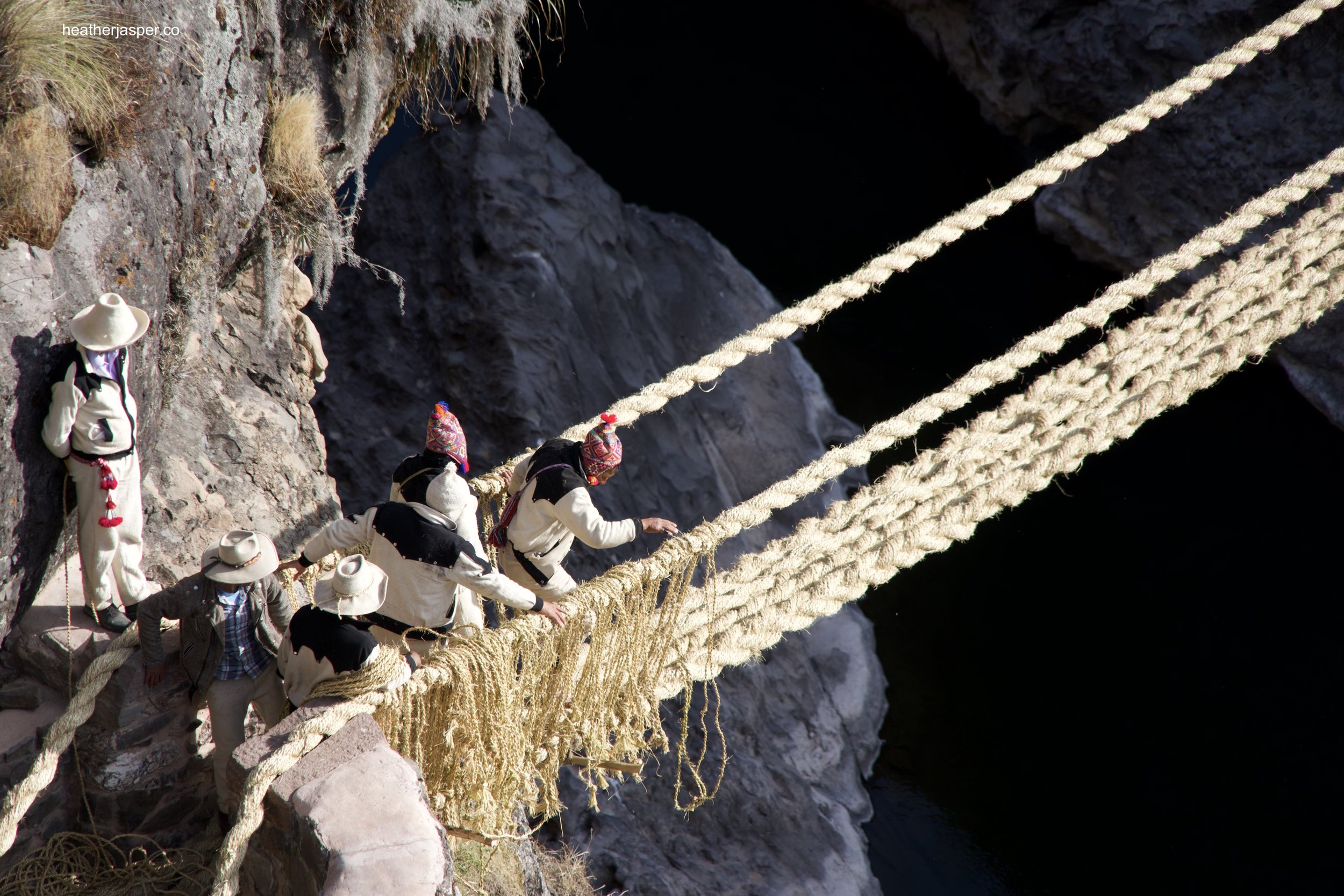
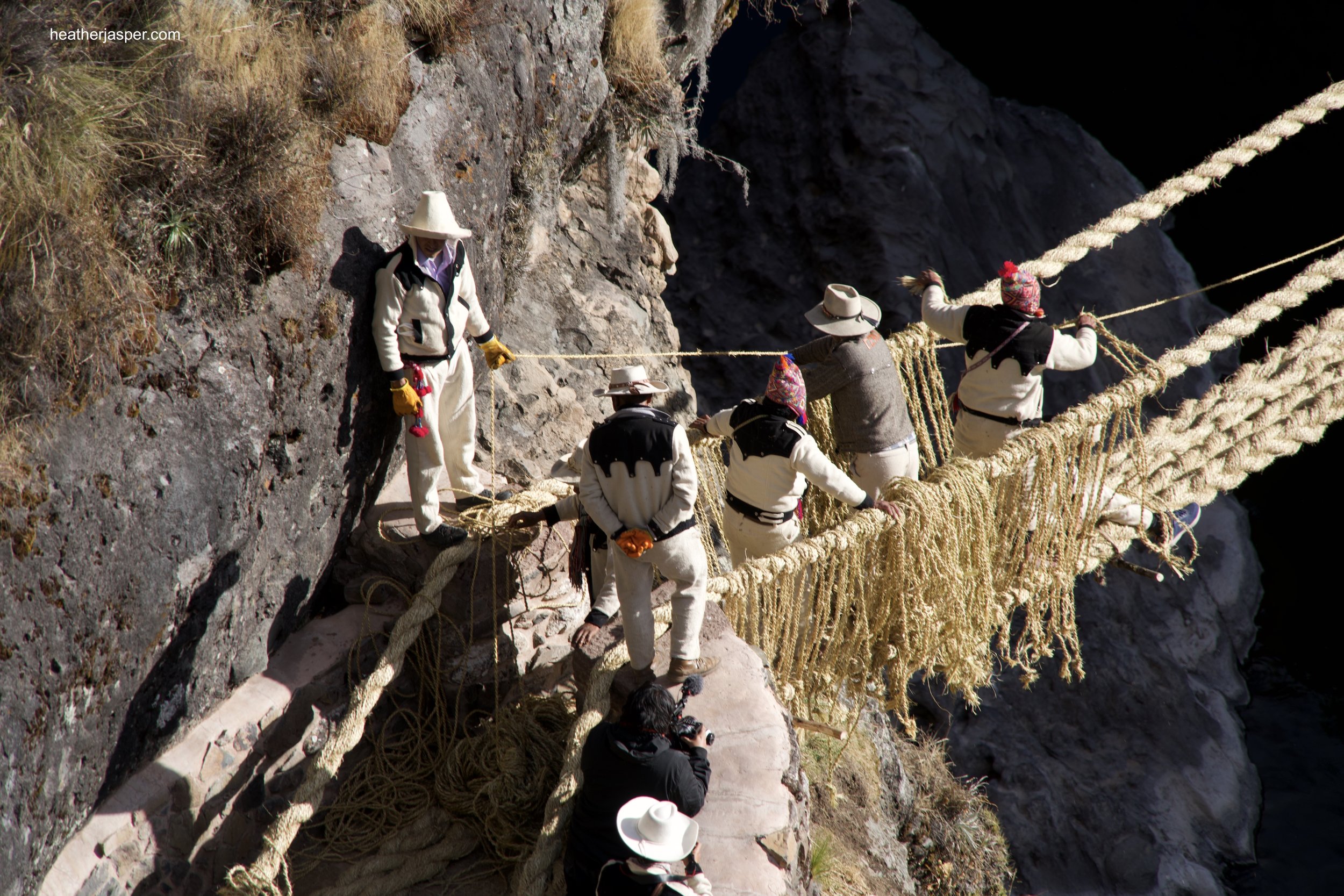

The group working from the east side constantly had to have ropes sent over from the other side of the canyon, where all the women were working. At one point, a man crossed from the east to the west side. (below) Being a woman, I wasn’t allowed down in the canyon, so I couldn’t ask why he did that. He came back with a bundle of ropes over his shoulder, the same ropes that other men were hauling across the canyon, dipping them down into the river to keep them damp and easy to work with.

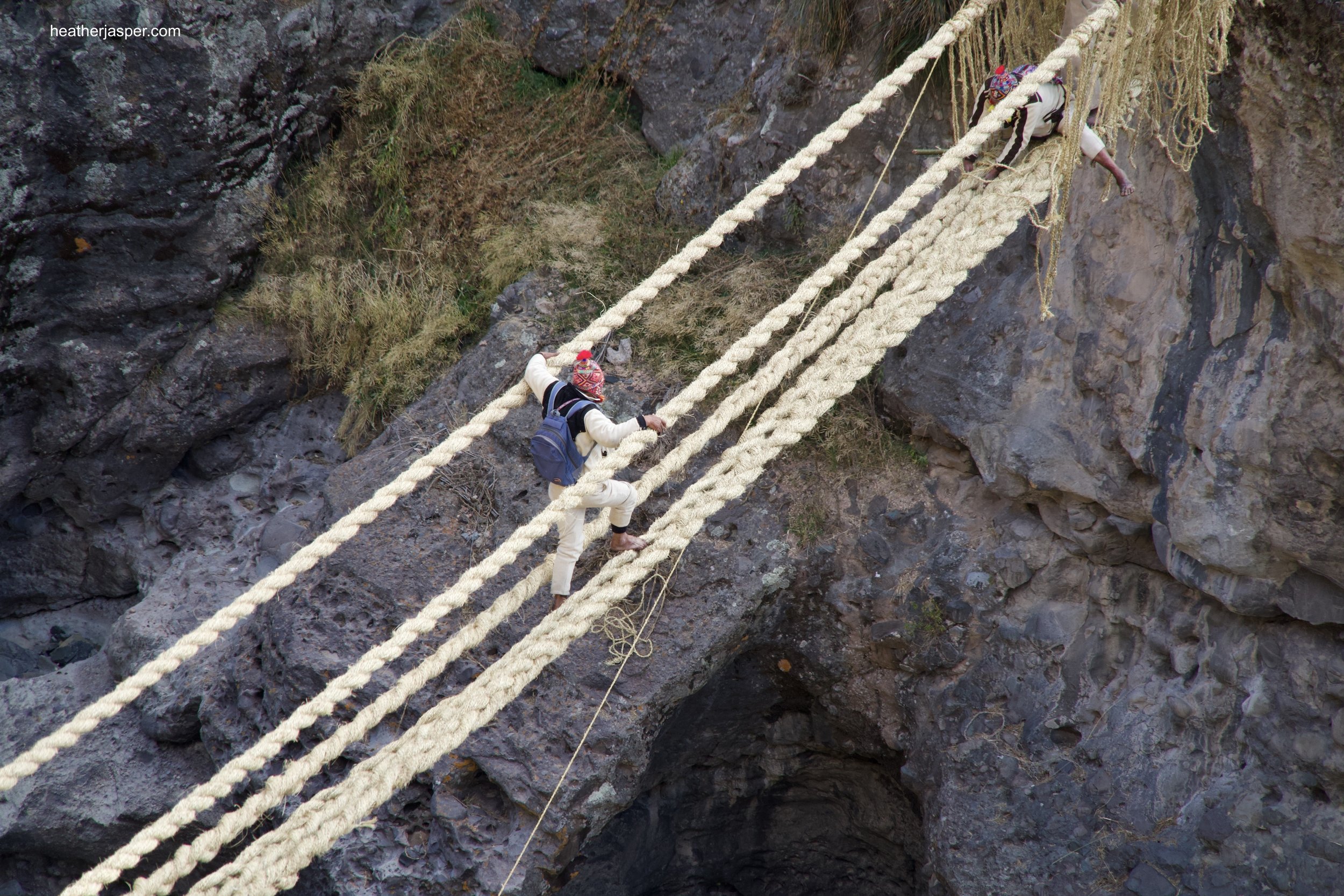
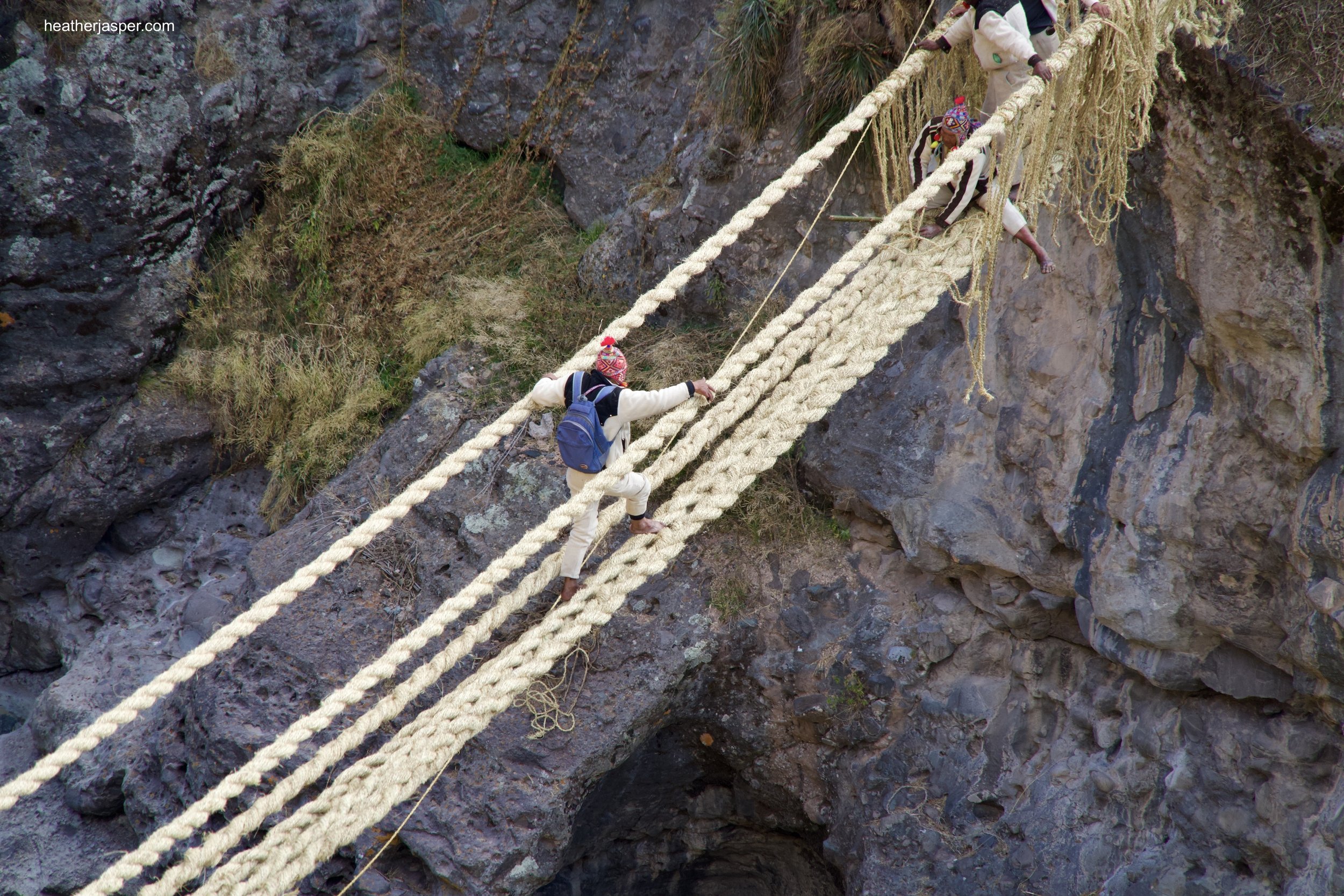
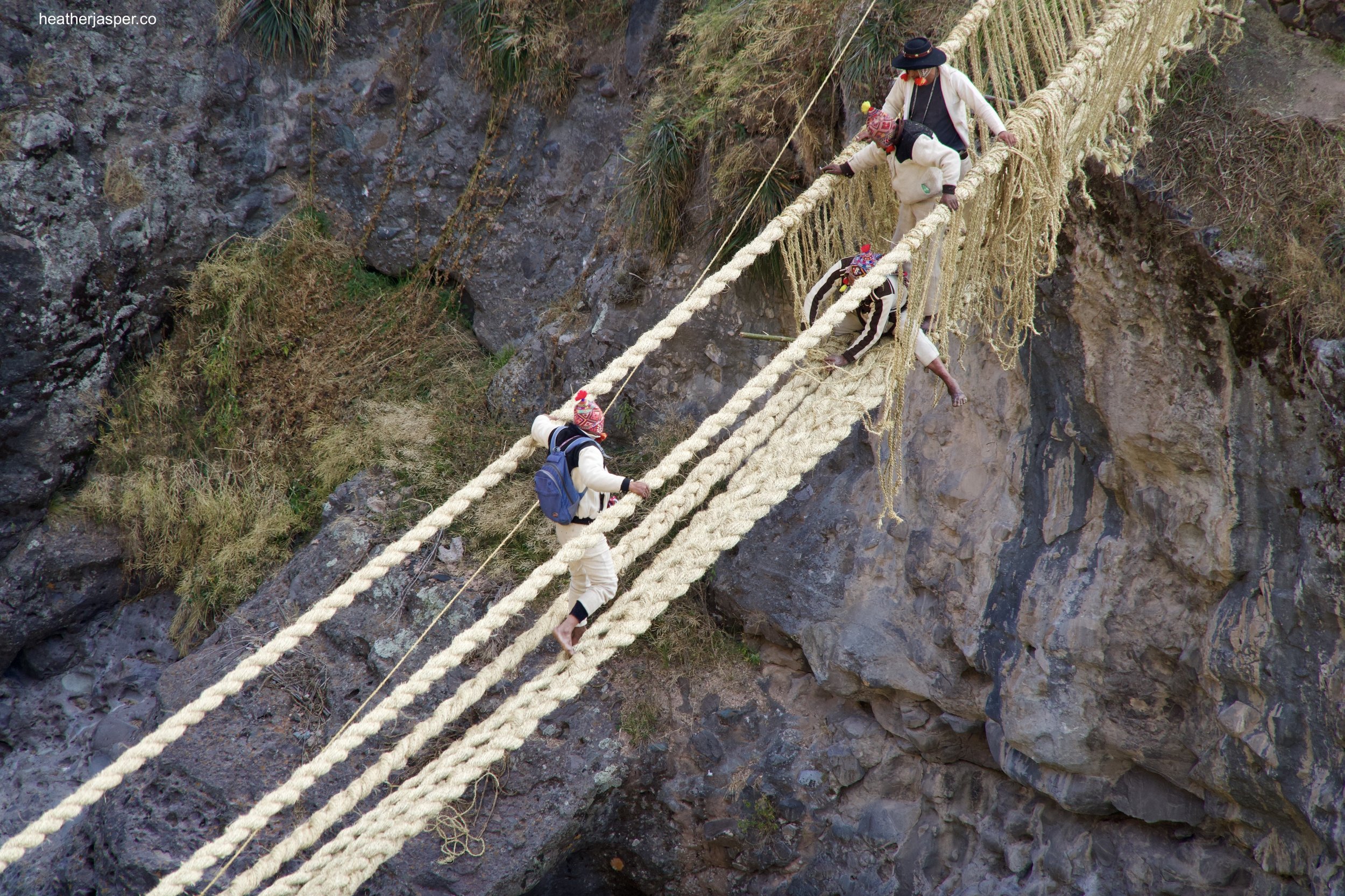
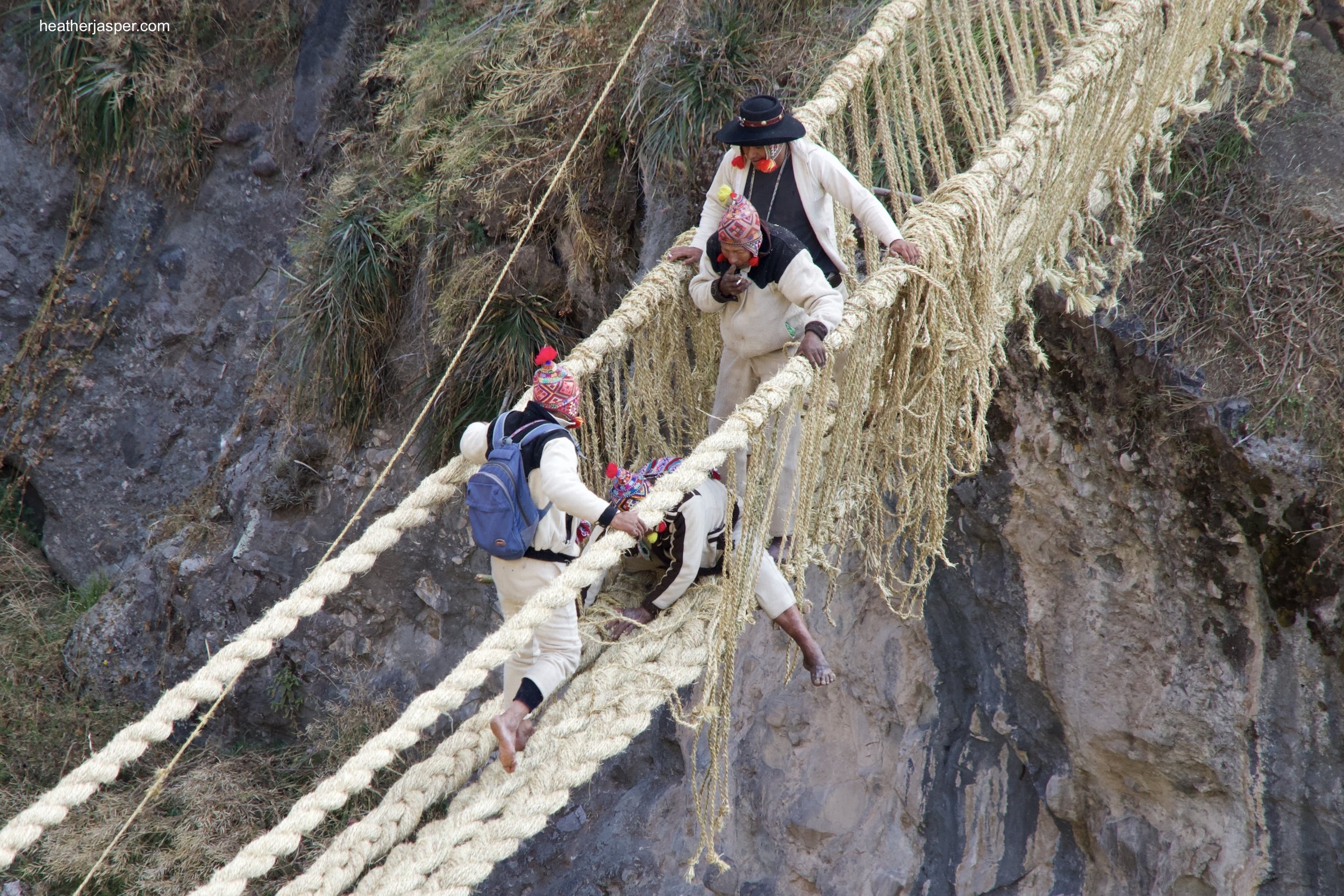
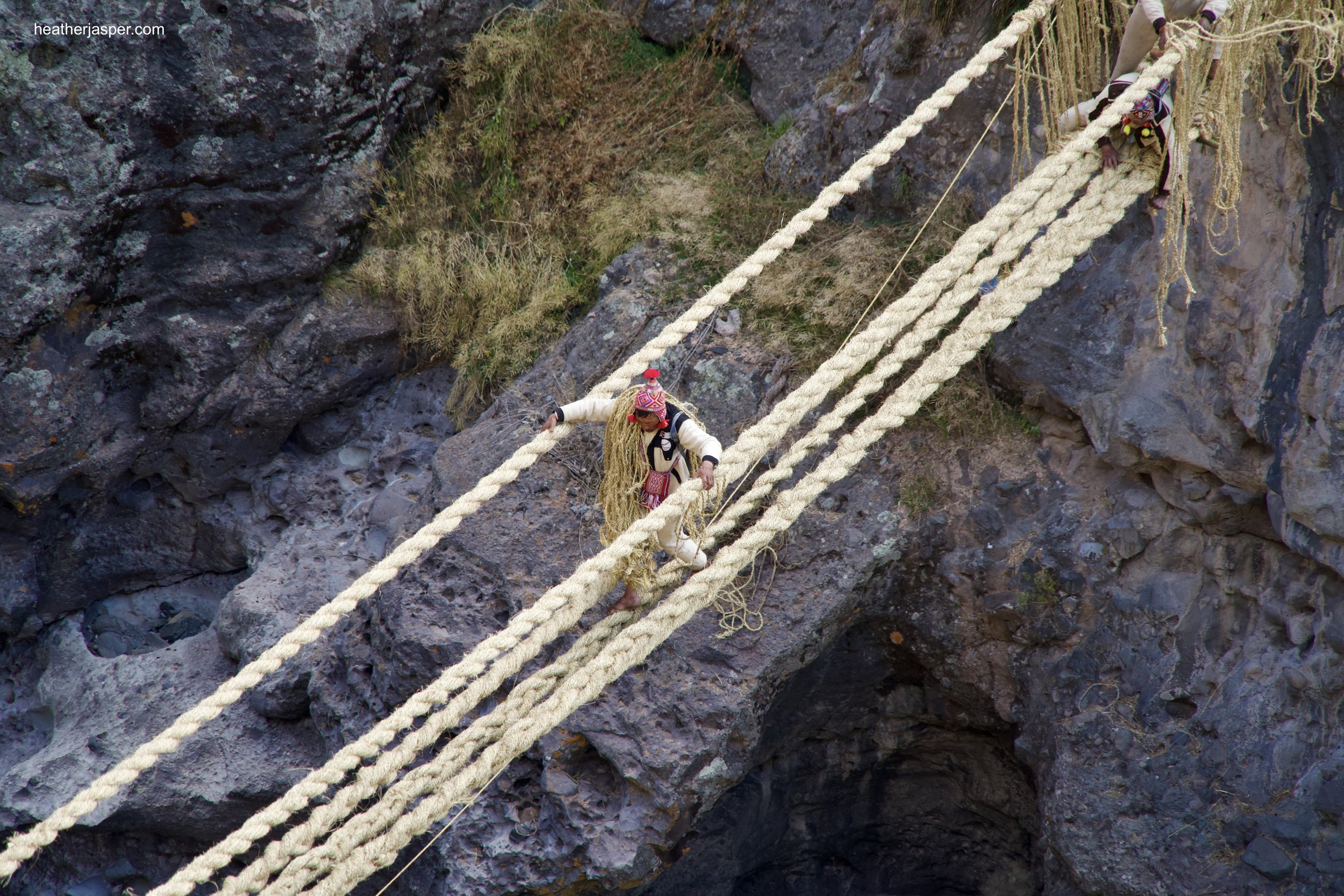
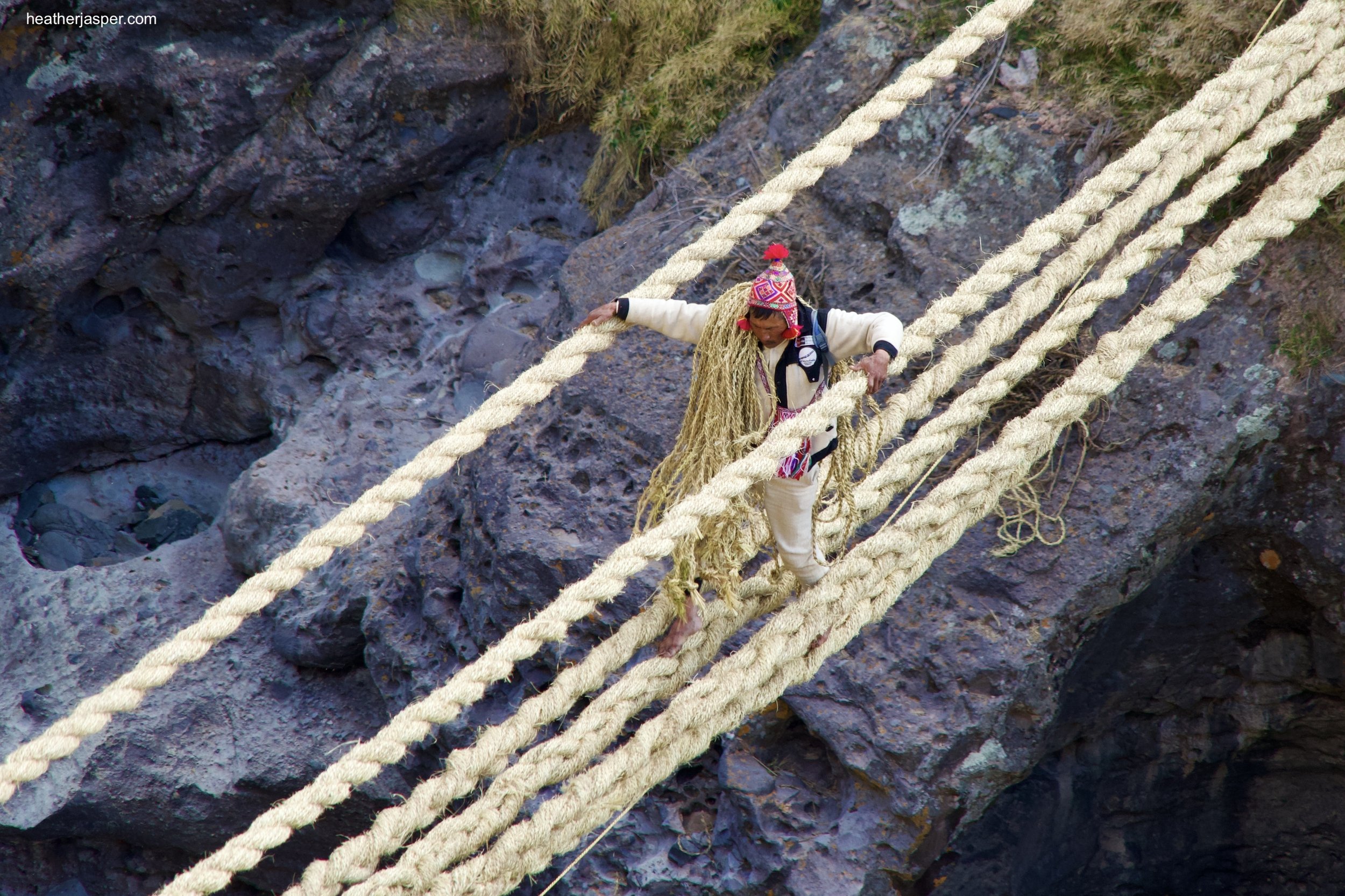
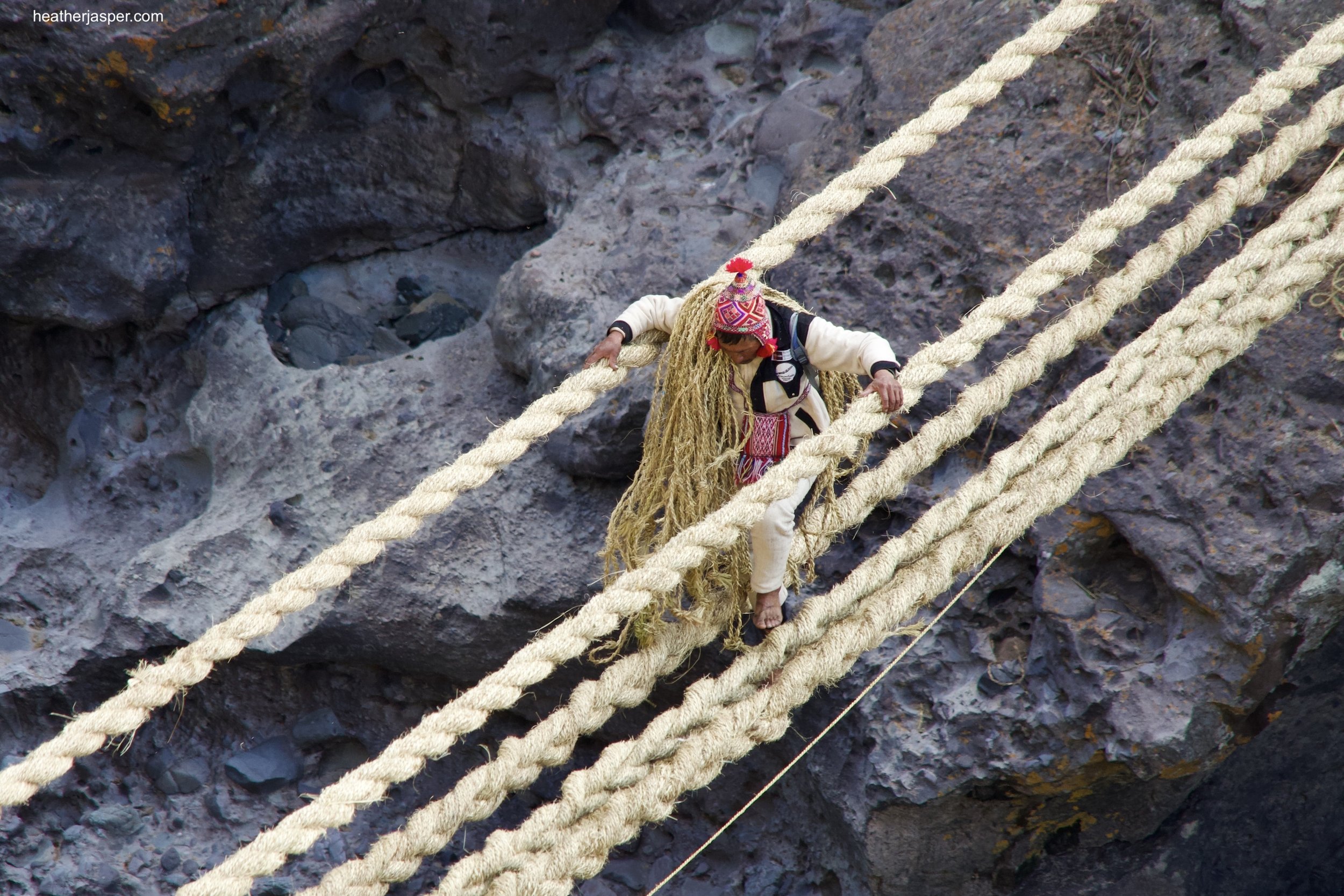
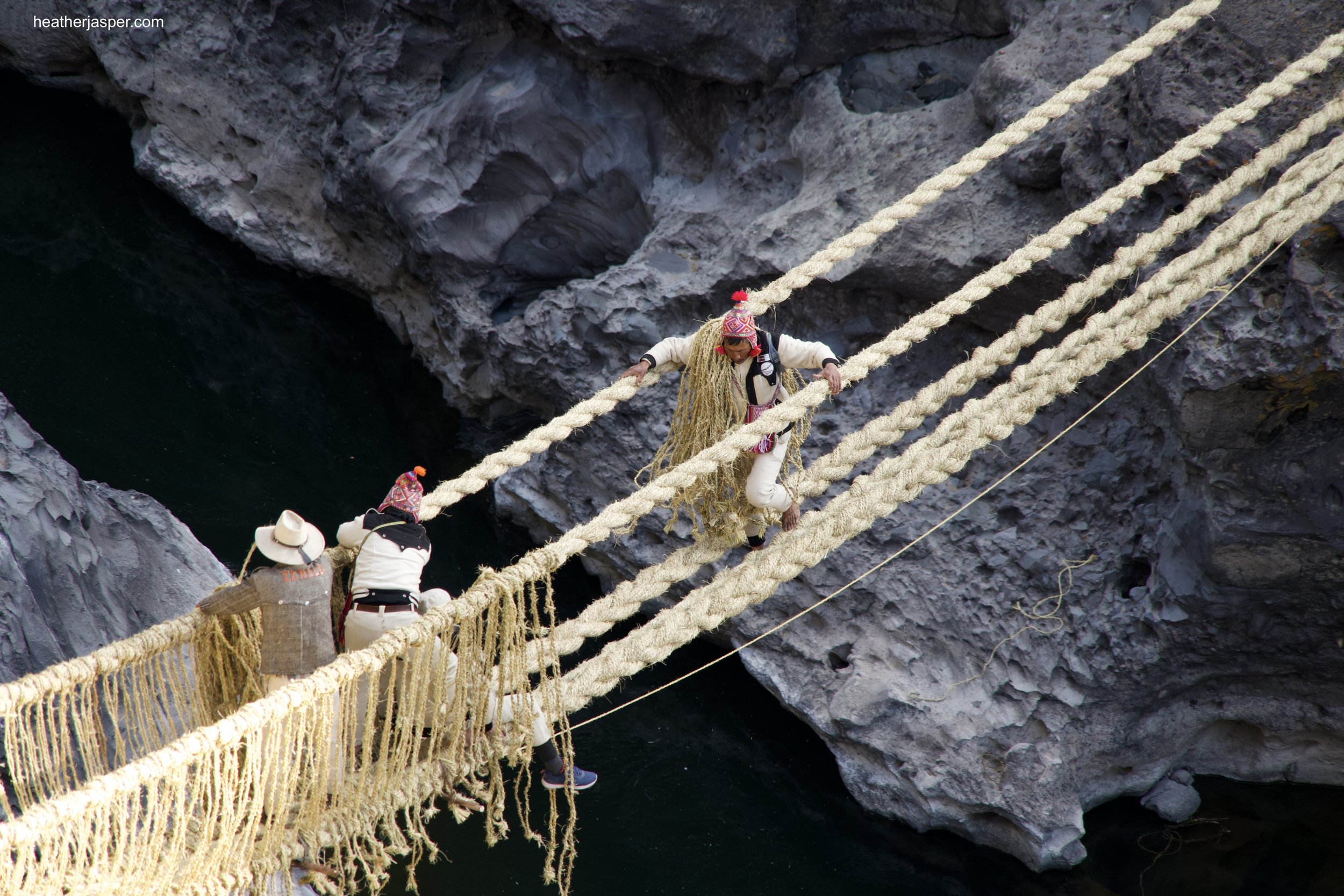
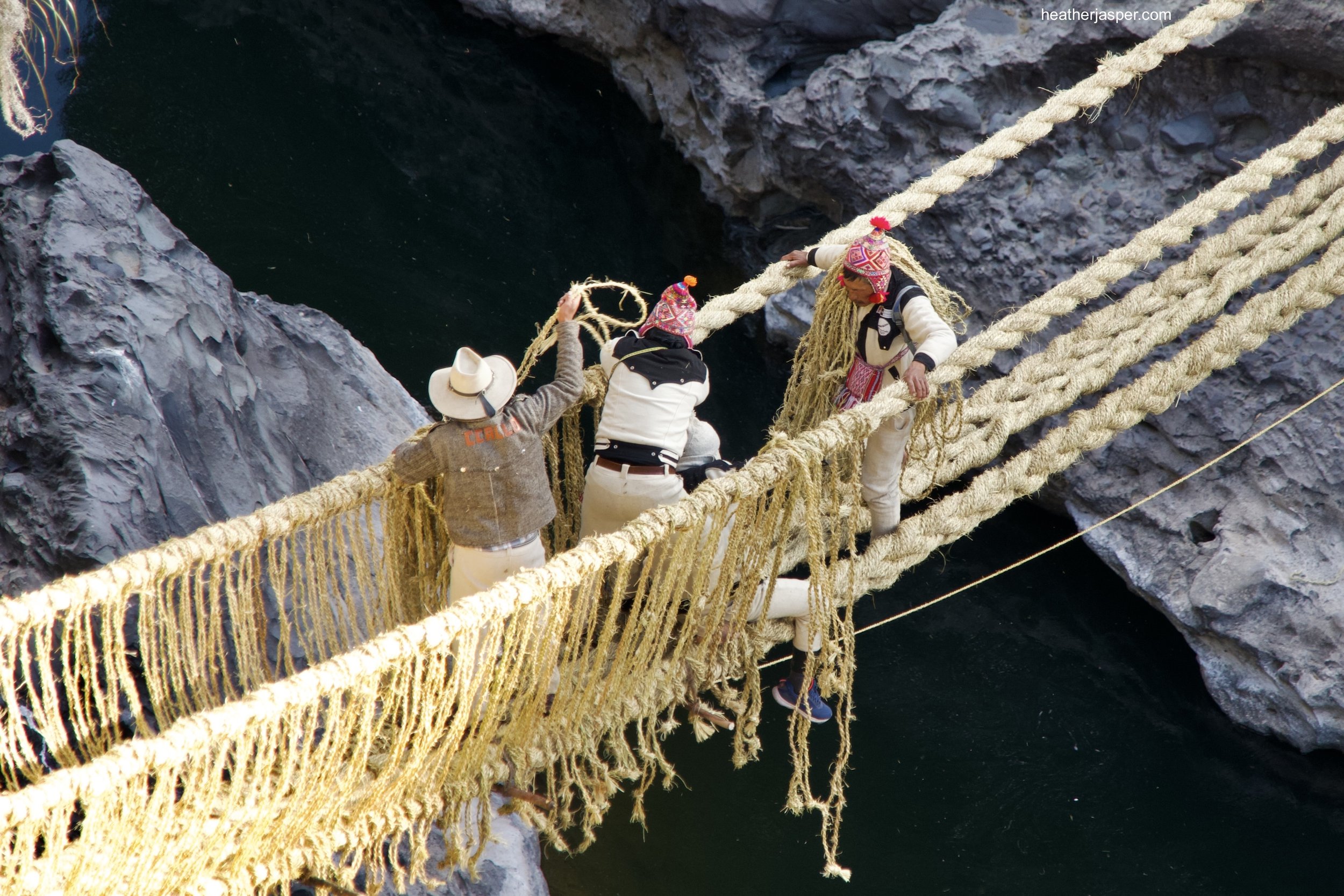
Was this the original slacklining? People have been making this bridge for well over 500 years, so it stands to reason that people have been walking across the unfinished bridge for some reason or another at least that long.
Other than that slackliner above, all the short ropes for the sides of the bridge were brought across the river in bundles that were first soaked in the river. Nobody else crossed the bridge until it was completed. (below)
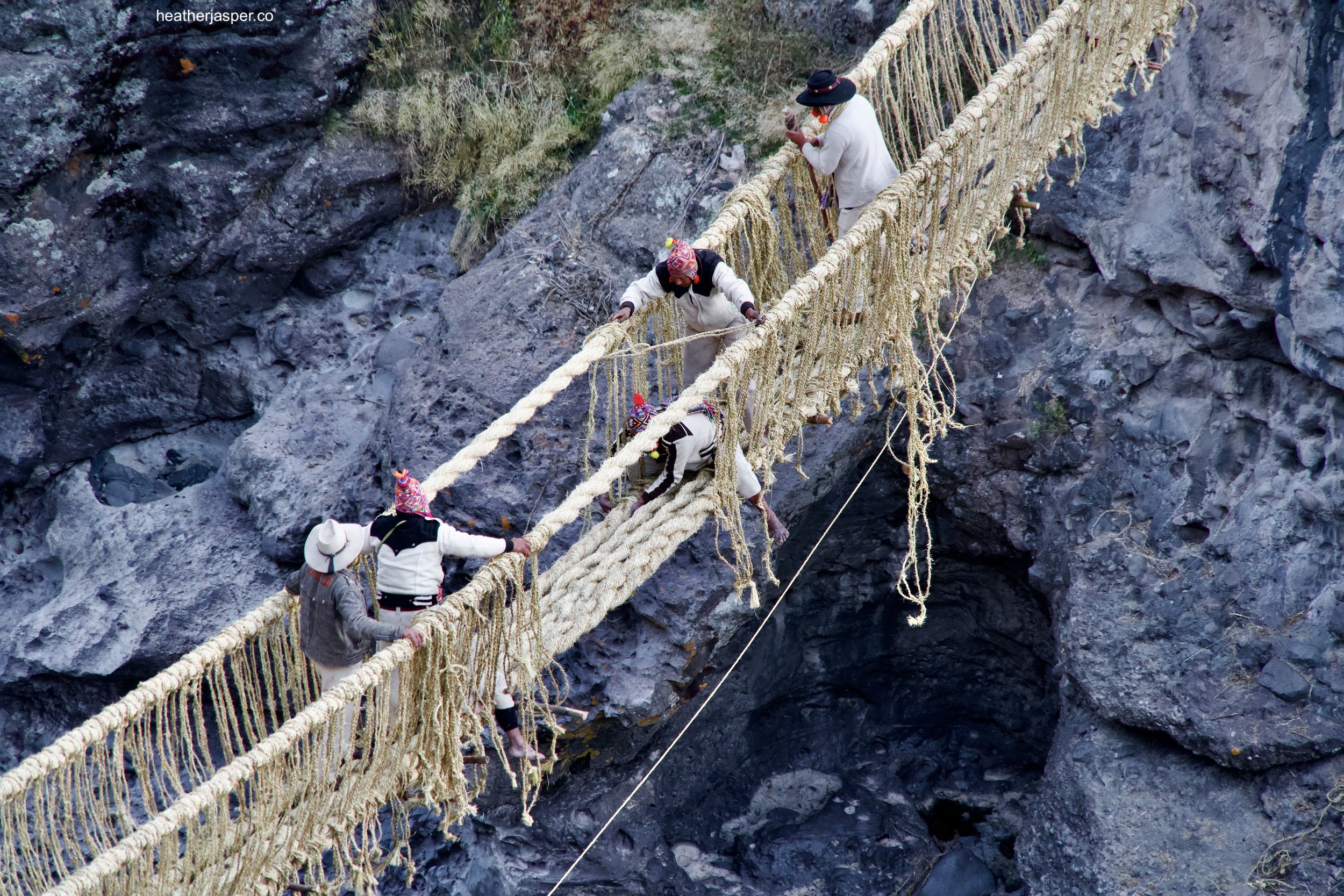
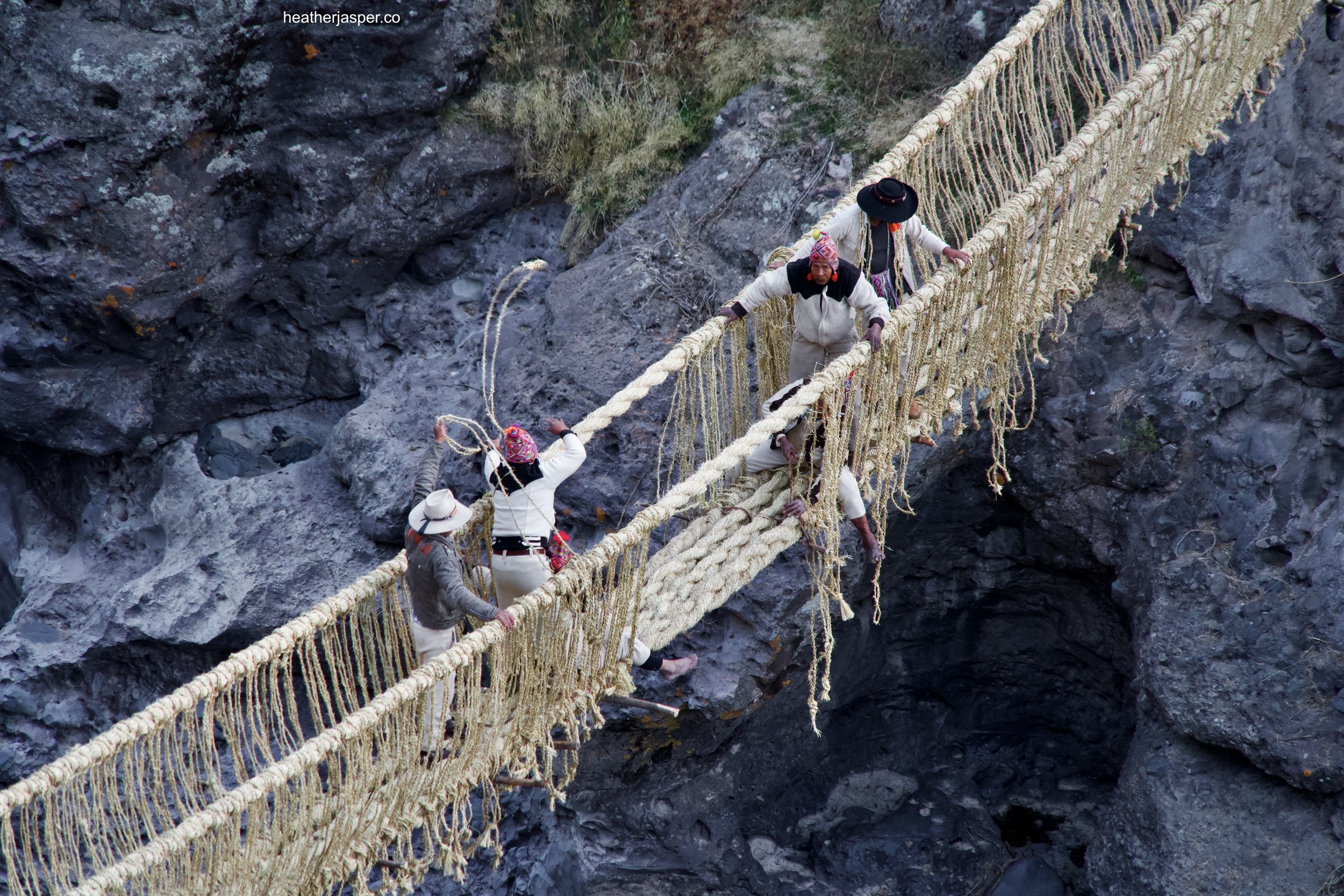
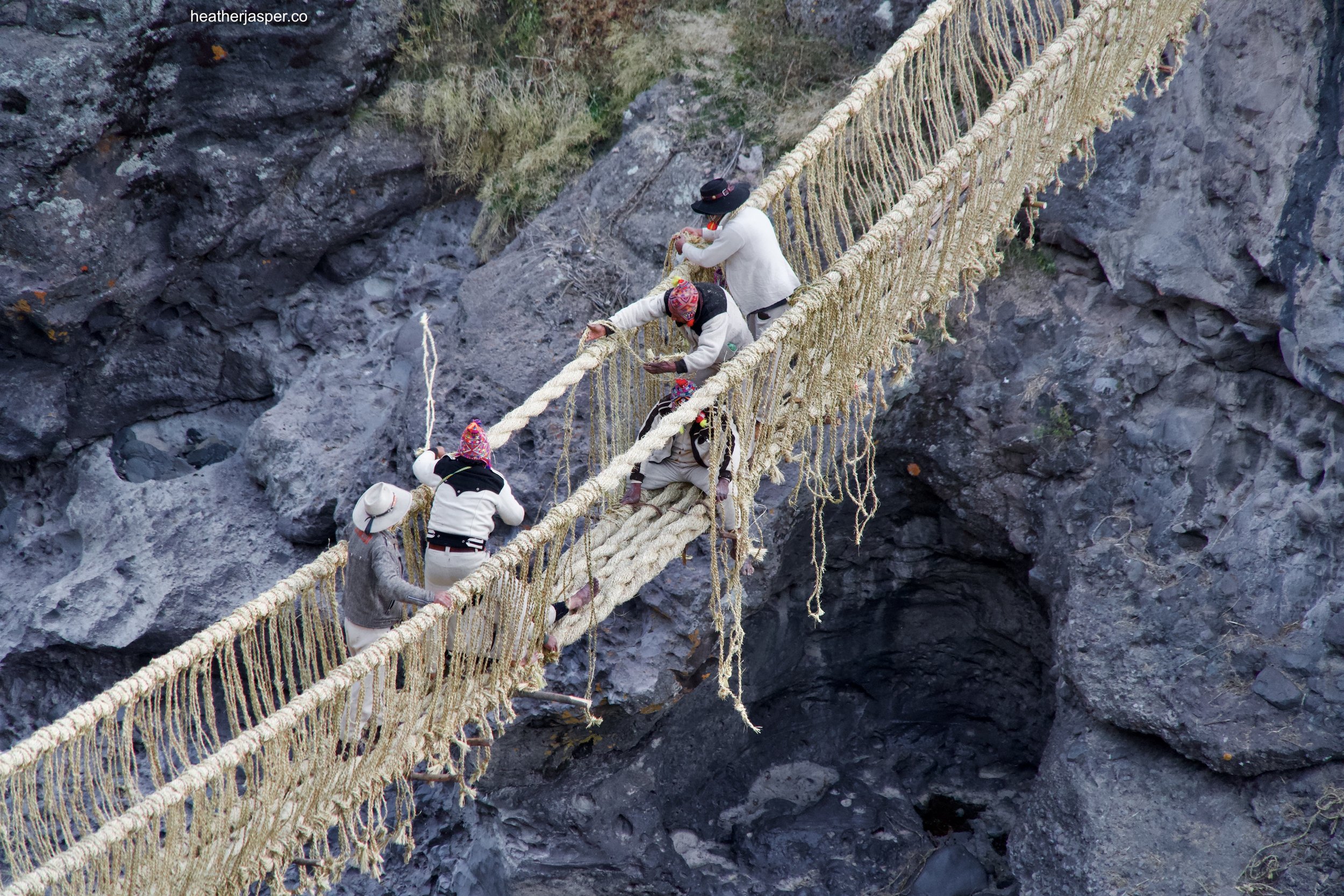
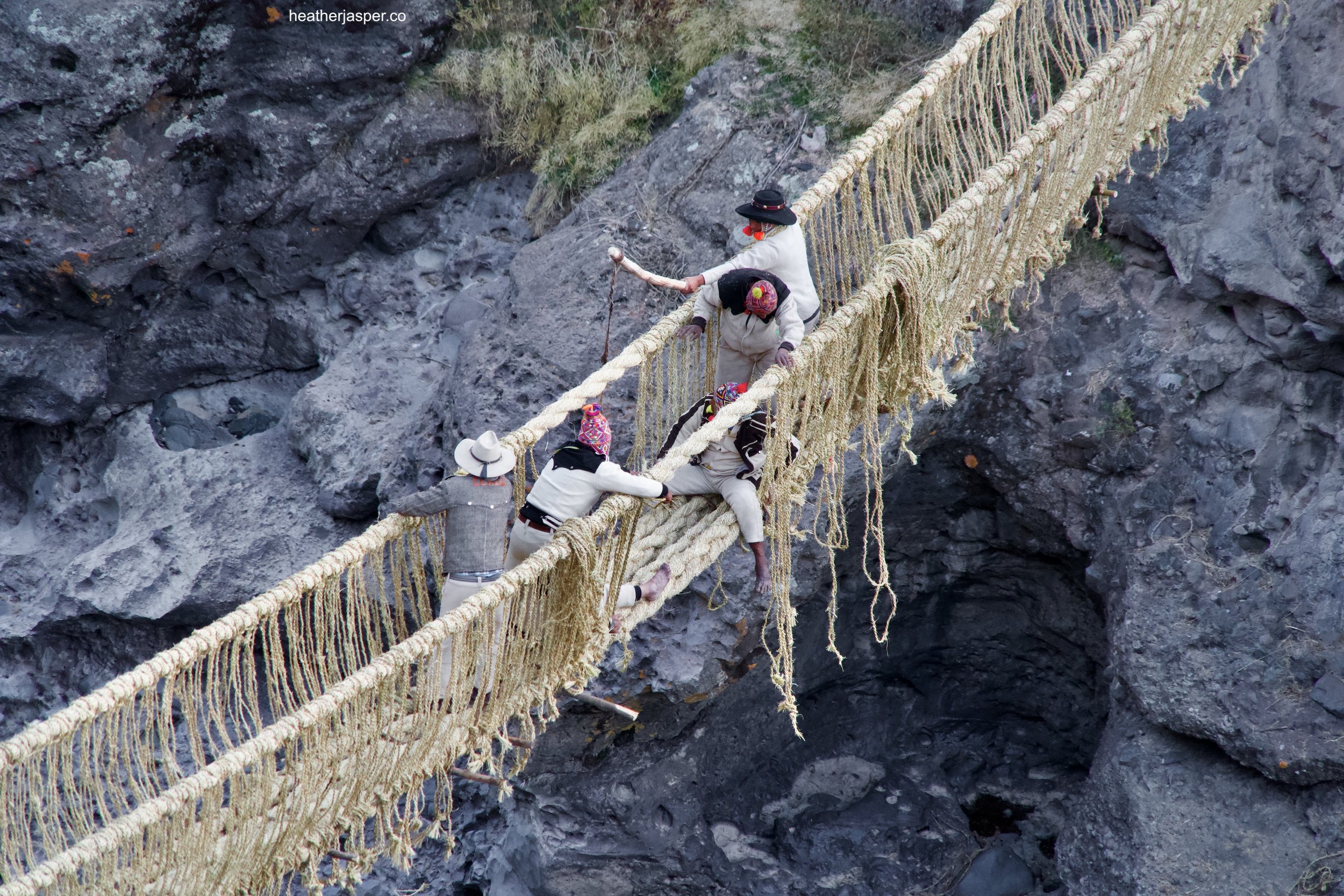
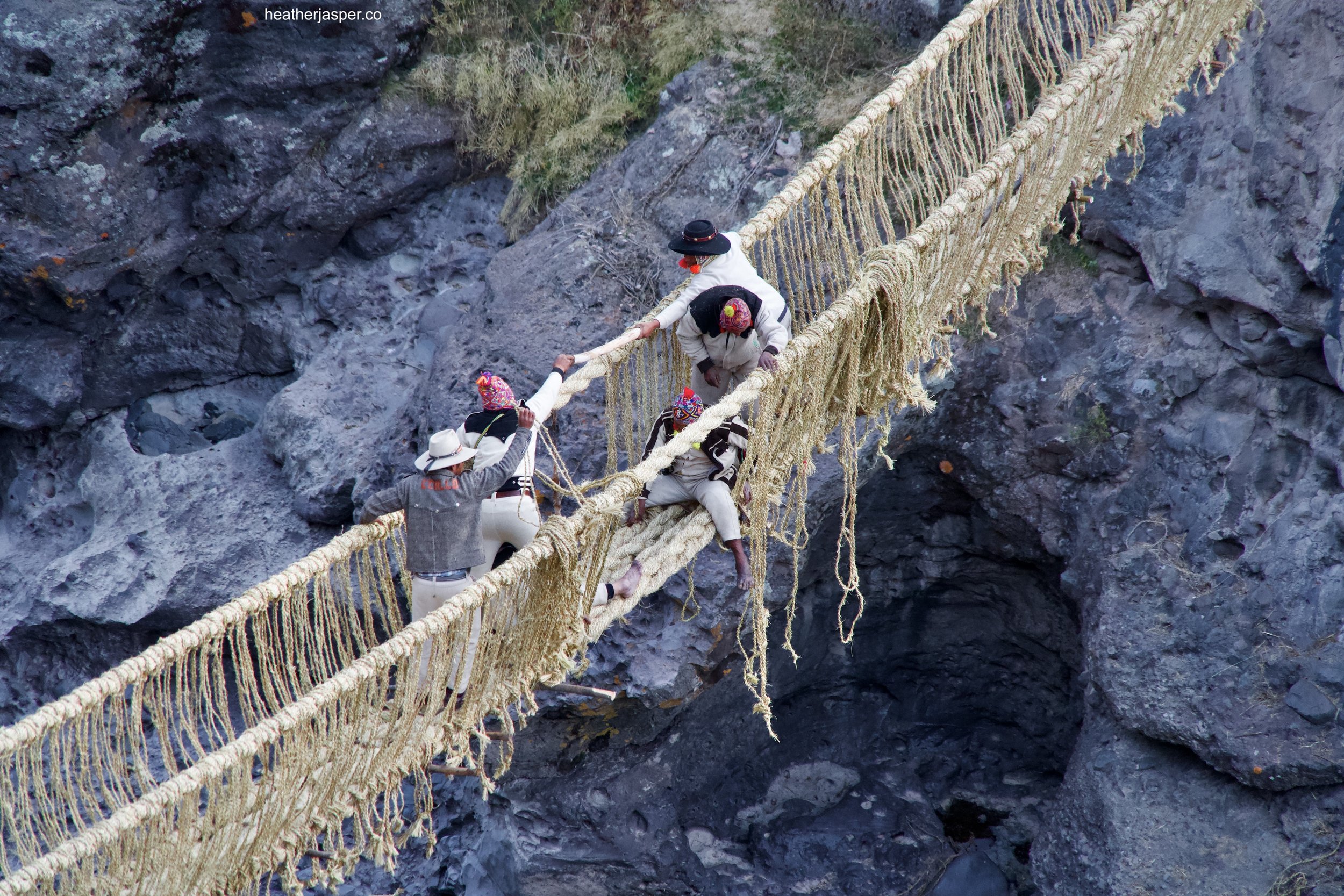
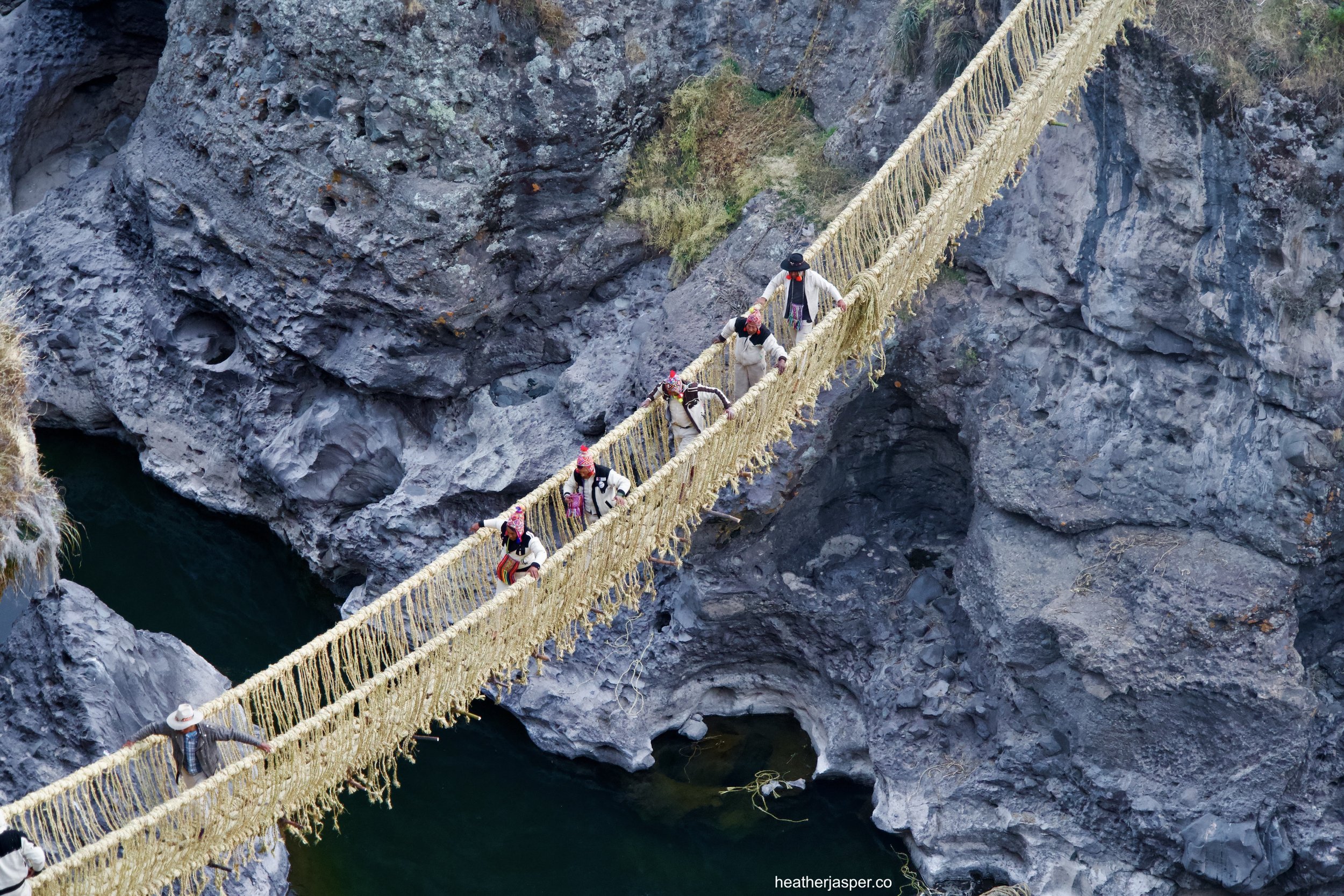
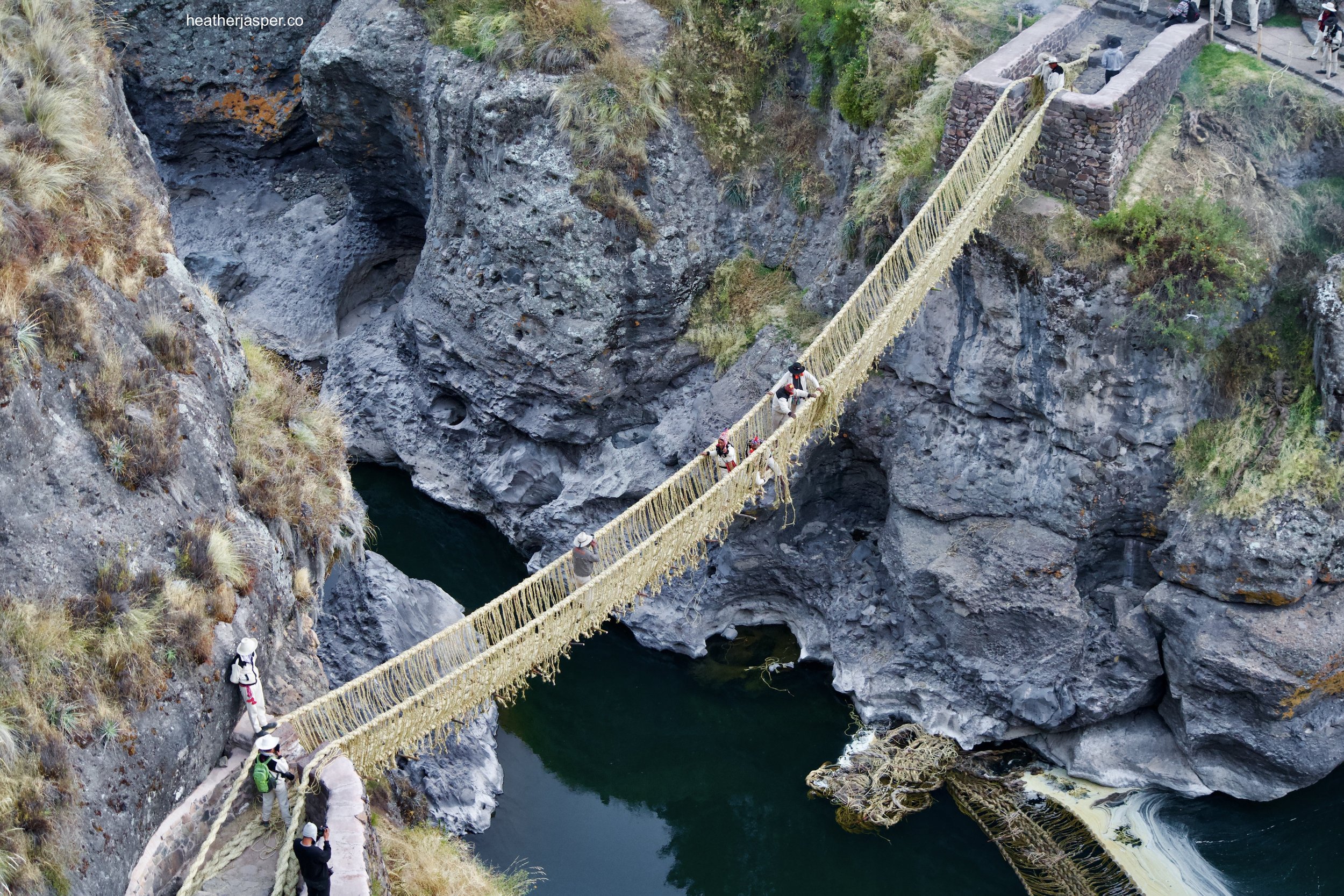
While two teams of men are tying on the side ropes, dozens of other men are making a cover for the braided floor ropes. They spent days cutting sticks the same length and now have to tie them together with trips of rawhide. Of course, they also have to cut the strips of leather that they use to tie the sticks together.
After the sides of the bridge are done, it was time for the men who had been making the stick floor to carry the rolls down into the canyon. It was rolled across from west to east – and then it was finally done!
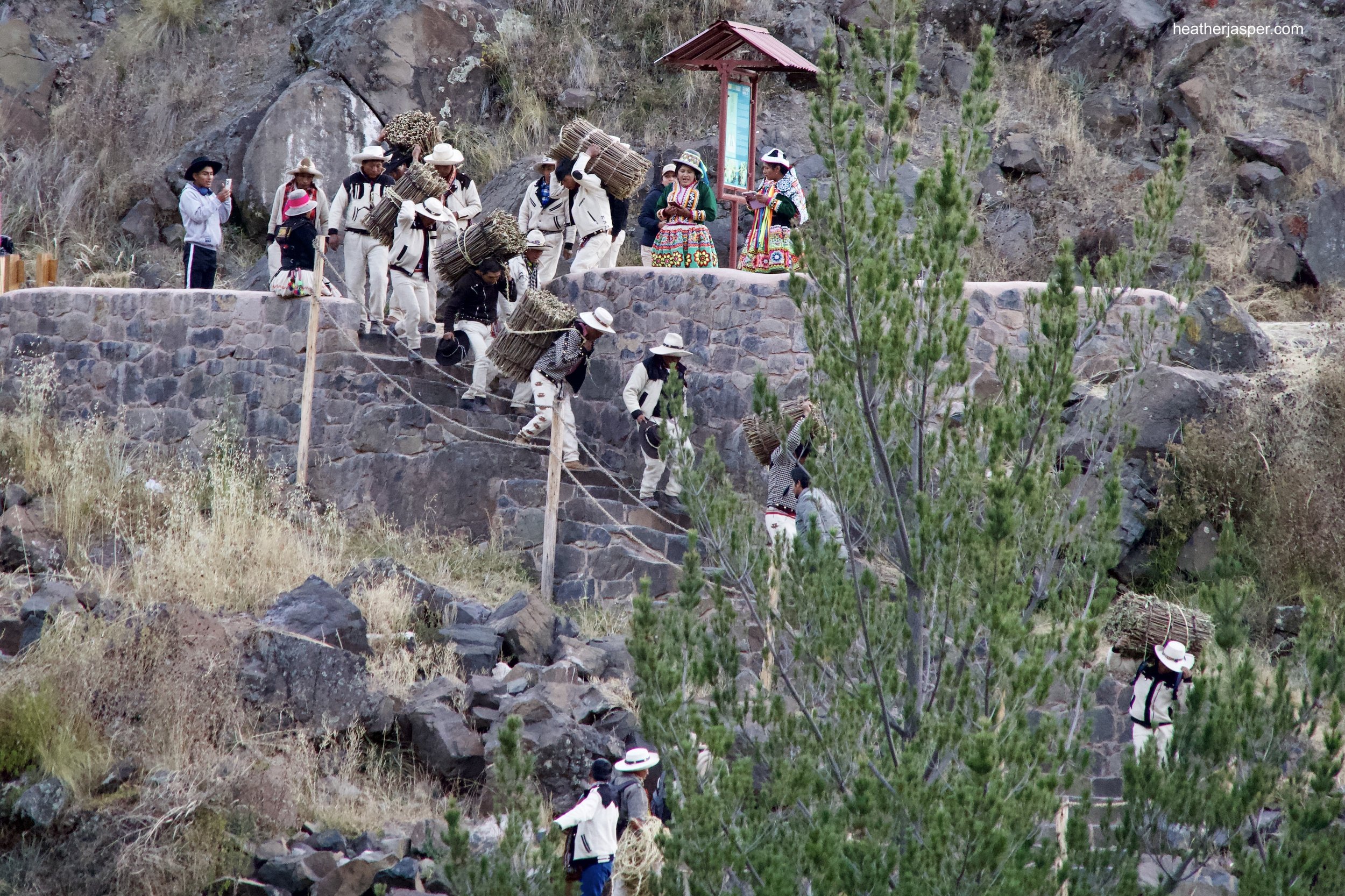
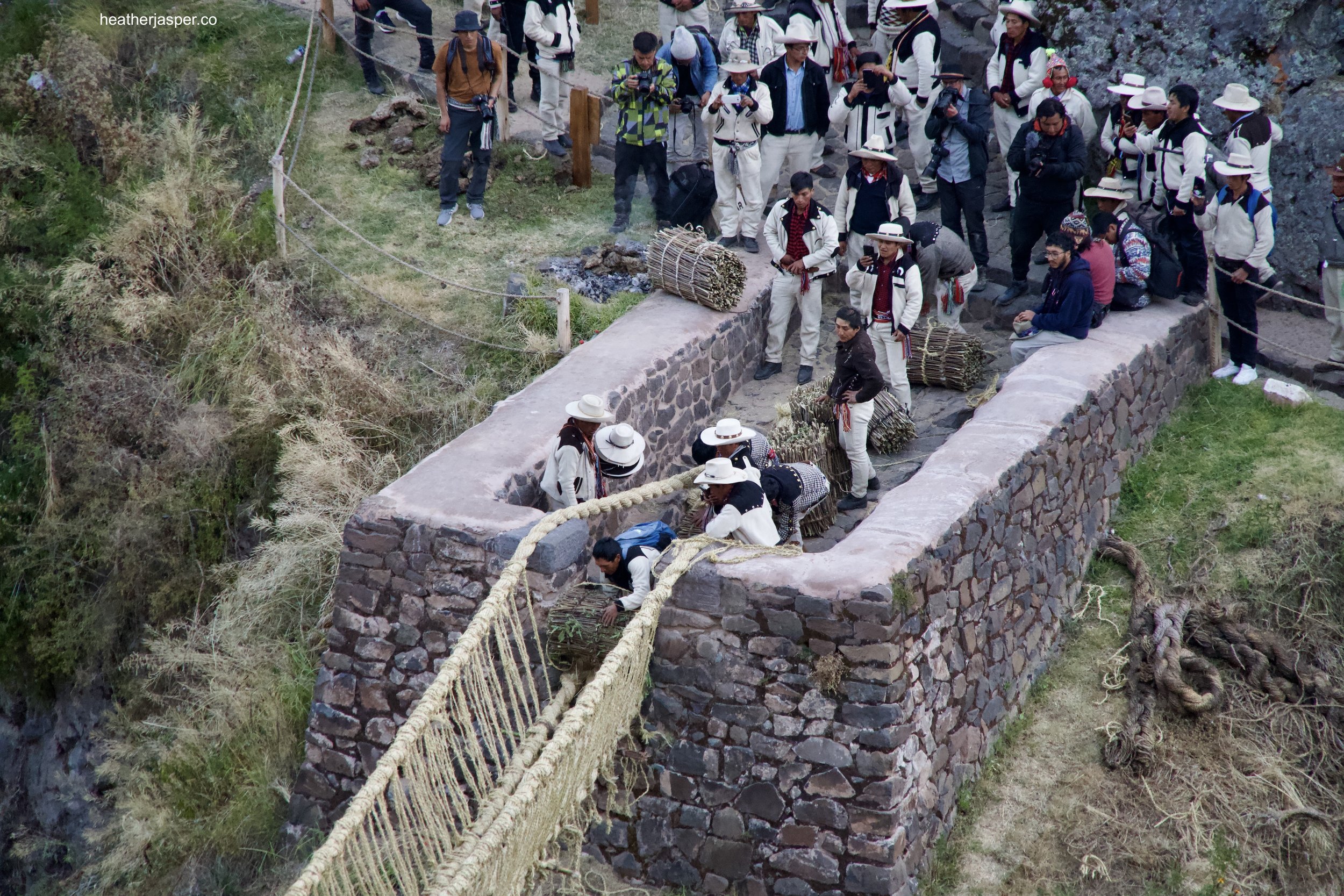
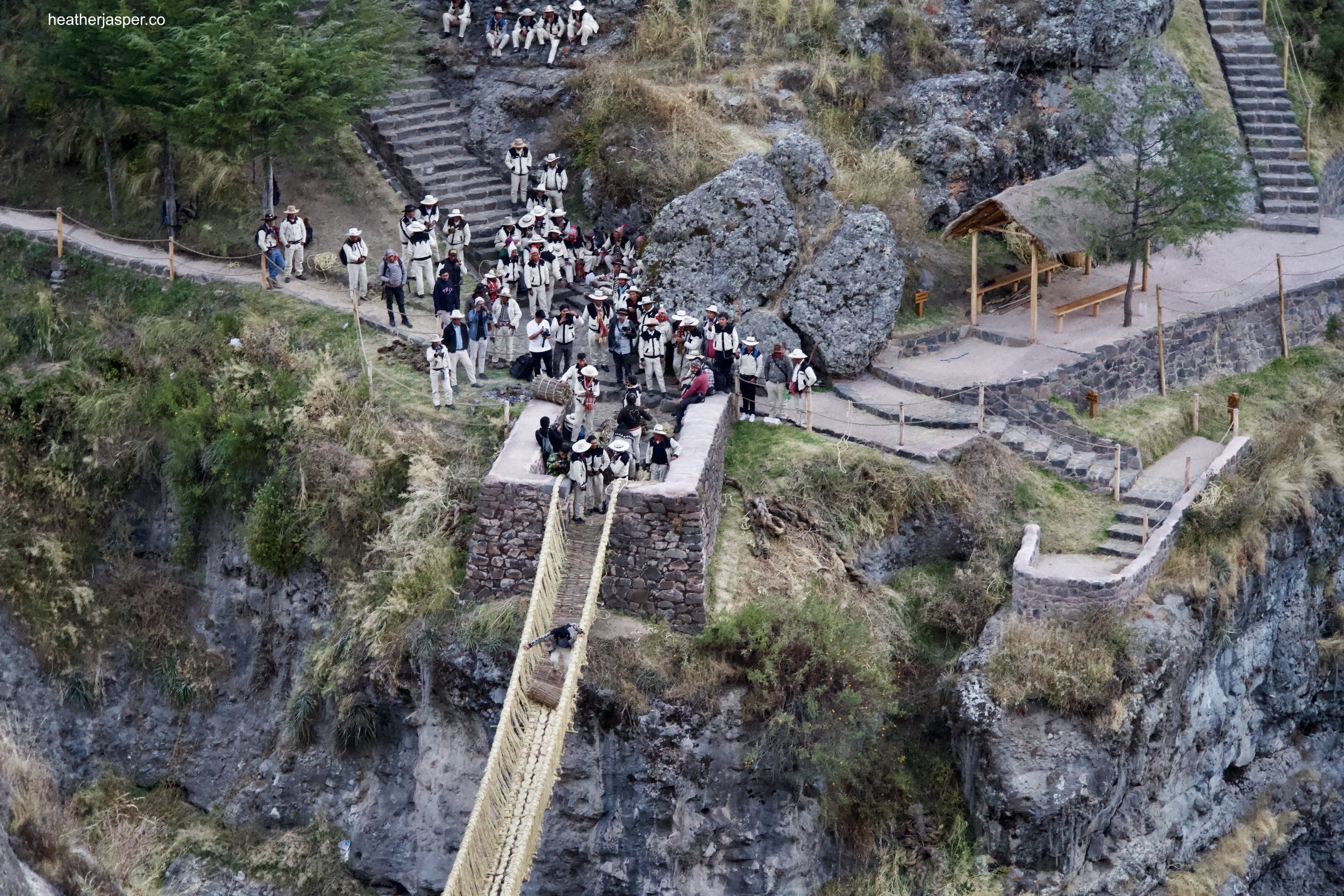
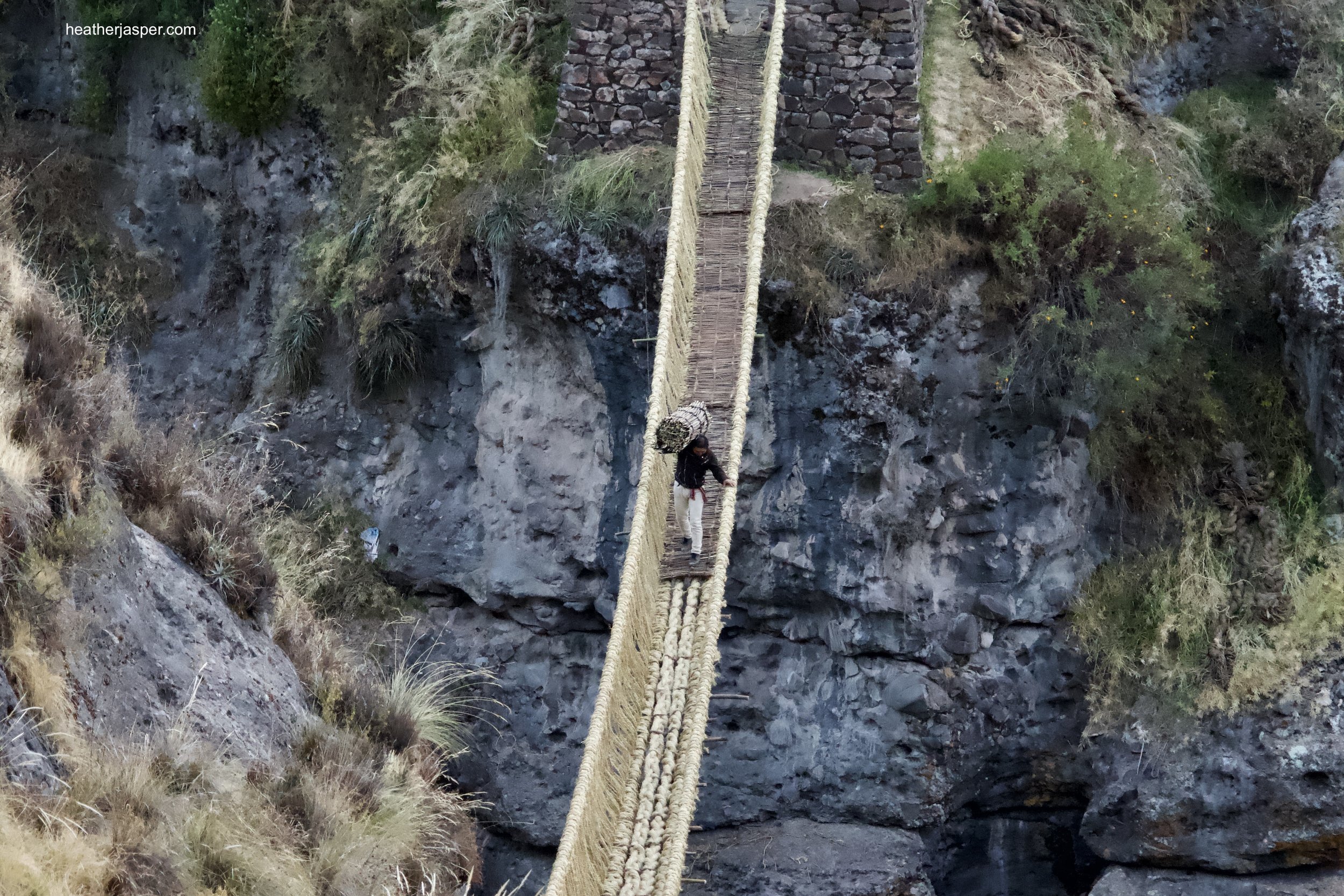

By that time, it was getting dark, and we had a four hour drive back to Cusco, so we didn’t stay to walk across the bridge. I was told that as a woman, I’d have to wait for the next day anyway.
Watching the bridge building
I plan to go back next year and stay for three or four days, so I can see more of the prep before they build the bridge. I also want to see them cut the old bridge down and walk across it after they finally let women down into the canyon.
How to get there?
There is no public transportation to Q’eswachaka, so you need to hire a taxi. That costs s/350-400 (about $100 USD) depending on the size of the vehicle. The road is paved until you get past the lakes, and then farther south it’s a rough road that’s partly paved and partly dirt. It takes about four hours - each way.
Homestays near Q’eswachaka Inca Bridge
This woman offered me a room in her house towards the end of the afternoon, but since we were leaving I neglected to get her name or phone number. Next year when I go back, I’ll take my tent and sleeping bag, but I might get to sleep in somebody’s home. I’ll update this in 2024 so you can see where I end up sleeping!


